 | E-mail to Birds Korea |
 | KWBS |
in the Region
 | The Oriental Bird Club |
 | BirdLife International (Asia) |
May
Like April, a great birding month. Temperatures begin to climb with day maxima often reaching 25°C by the end of the month, though feeling cooler on offshore islands due to low sea temperatures and wind. Fog can temporarily limit birding, while also causing spectacular falls of migrants.
Migration continues, and persity can be exceptional. Mongolian Plovers, Red-necked Stints, Broad-billed and Spoon-billed Sandpipers peak at the Geum Estuary, while Chestnut and Little Buntings outnumber Yellow-throated and Black-faced Buntings. Mugimakis, Dark-sided and Grey-streaked Flycatchers also start to arrive, often peaking in the second and third weeks of the month. Brown and Thick-billed Shrikes, Siberian Rubythroats and Broad-billed Rollers add colour and quality to the birding mix. By late May locustella warblers (Lanceolated, Pallas’s, Middendorff’s, Stayn’s and Gray’s Grasshopper) arrive on western islands. In forests Ruddy Kingfisher and very small numbers of Fairy Pitta are in territory and vocal, though still elusive and easily disturbed. Korean breeding Chinese Egrets and Black-faced Spoonbills remain widespread at the best sites, and Saunders’s Gull have also nested in Gyeonggi Bay annually or near-annually since at least 1999.
In recent years May has produced several sightings of national rarities like Common Chiffchaff, Band-bellied Crake, Black-winged Cuckoo-shrike, Cinnamon Bittern and Red-headed Bunting. "Korean firsts" in May have included Asian Drongo-cuckoo, Hill Blue Flycatcher, Spotted Dove and House Sparrow in 2006, and Large Hawk-cuckoo and Yellow-streaked Warbler on Socheong Island in 2007.
(The following records are a compilation of our own sightings and records sent in by other observers. As well as being posted on the Birds Korea website(s), selected records are also forwarded to other Korean-language birding websites; records of threatened species are arranged and forwarded to Birdlife International and national authorities when appropriate; flag images and records are passed to bodies responsible for their coordination throughout the flyway; and all records sent to us are used to compile annual reports and to support the evolving understanding of the status of many of Korea’s birds.)
Seosan and Weyeon-do, May 30-31
May 30. An afternoon at Seosan produced one Black-capped Kingfisher, one rather shy Watercock and one Eurasian Eagle Owl.
May 31. The morning boat to Weyeon was extremely quiet bird-wise and the island first promised to be the same. In hot, clear weather: several Cattle and Intermediate Egrets, 3 Chinese Grosbeaks, a single Brown Shrike, 3 Thick-billed Shrikes, a Chinese Sparrowhawk and a Honey-buzzard, a few roving groups of Japanese Whiteyes (with one Chestnut-flanked glimpsed in flight), a single Yellow-browed Warbler calling, small numbers of calling Japanese Bush, Korean Bush and Oriental Reed Warblers, 2 Yellow-breasted and 2 Chestnut Buntings, a couple each of (heard) Common, Indian, and (heard and briefly seen) Little Cuckoos, and one Pechora Pipit. Best finds came in the afternoon: a singing Gray’s Grasshopper Warbler, long (and close) heard but not seen, and, best of all and only 20 minutes before the return boat, a cracking male Cinnamon Bittern flushed at close range from thick grass at the (largely dry) wetland area.

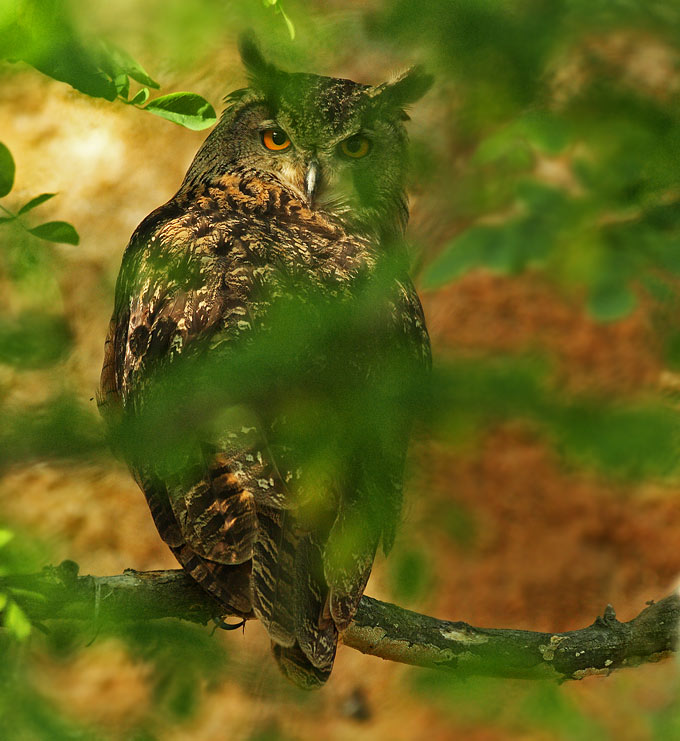
Dokjeok Island, May 31
A pair of displaying Northern Hobby greeted me the following morning, along with 1 Oriental, & 2 Common Cuckoo, 4 Eastern Yellow Wagtail and a single Yellow-browed Warbler.
More birds with island territories included 2 Dollarbird, several Korean Bush Warbler, 2 Grey Wagtail, 2 Carrion Crow, Intermediate, Cattle & Little Egrets. Best for the morning a very skulking Pechora Pipit, which eventually gave a good but brief view before creeping, slow-motion into thick cover.
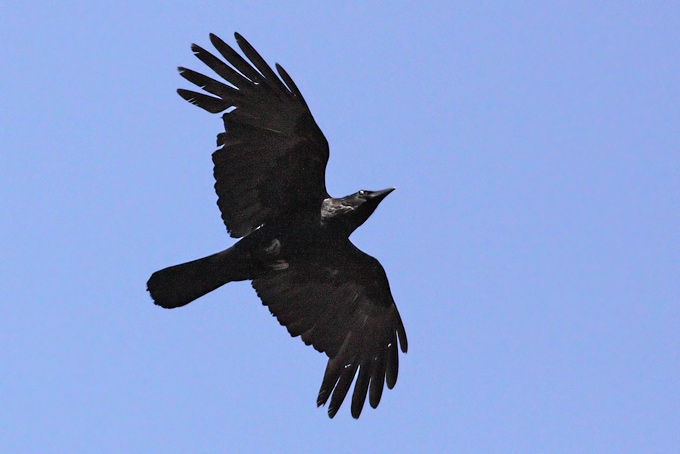
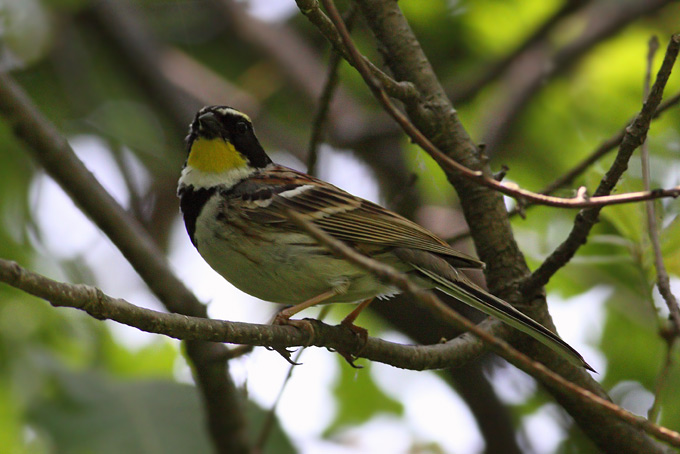
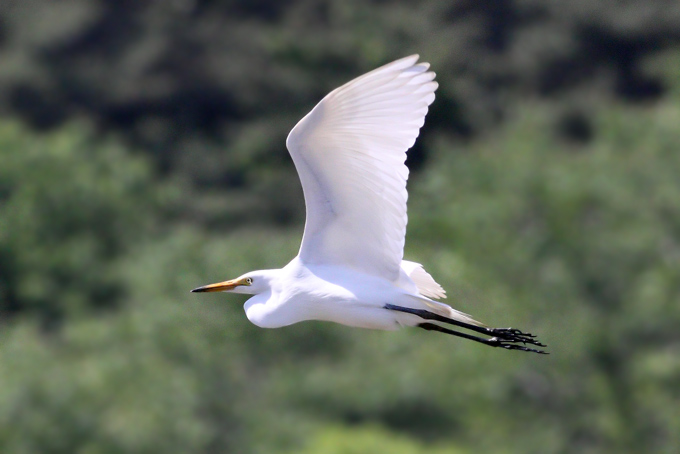
Dokjeok Island, May 30
On the crossing, several Little Terns and a Saunders's Gull just out of Incheon port. Between 4pm and sunset on the island, hard work to find birds, with very low numbers: of the few migrants, a close-up Lanceolated Warbler jumping into thick cover and 2 Asian House Martin accompanying an energetically feeding flock of c.15 Red-rumped and Barn Swallows.
On the ricefield 2 late Pintail seemed noteworthy, as well as 2 Mongolian Gull passing offshore (-nesting locally perhaps?). Otherwise, 3 Indian Cuckoo, 1 Chinese and 1 Japanese Sparrowhawk. Probable island residents (and breeding summer visitors) included 1 Siberian Blue Robin, 4 Great-spotted Woodpecker, 20+ Long-tailed Tit, 1 Grey-backed Thrush, and several Black-naped Oriole.
A mountain hike to the radio mast in time for dusk proved rewarding, with 2 or 3 Grey Nightjar resonating from the forest, including a close view of one low overhead just before dark- churring in flight.At around the same time, a calling Oriental Scops Owl and apparent Ural Owl- the curious single and double hoot closely matching sound recordings.
Gageo Island, May 25
A survey of Black Woodpigeon from 3-Gu to the Lighthouse and onto 2-Gu between 0630 and 2030 in calm and slightly sultry conditions happily produced an expected number of Woodpigeon, and a decent number of late migrants, with at least 78 species logged. Birds seemed to be arriving in the afternoon at 2-Gu, and species of most note there included a Black Drongo, two Red-billed Starling, two Light-vented Bulbul, four Thick-billed Shrike and three Thick-billed Warbler, a couple of Pechora Pipit, and probably twenty or more locustellas (mostly "rich-plumaged" Middendorff’s and similarly bright-looking Pallas’s Grasshopper Warblers, but including three or four Gray’s on the forest trail).
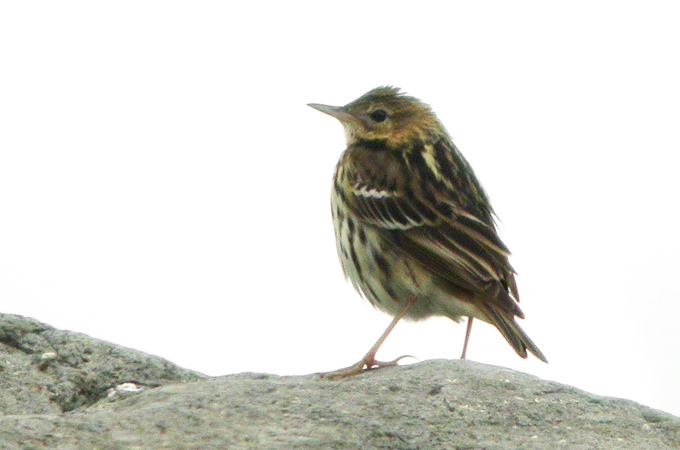
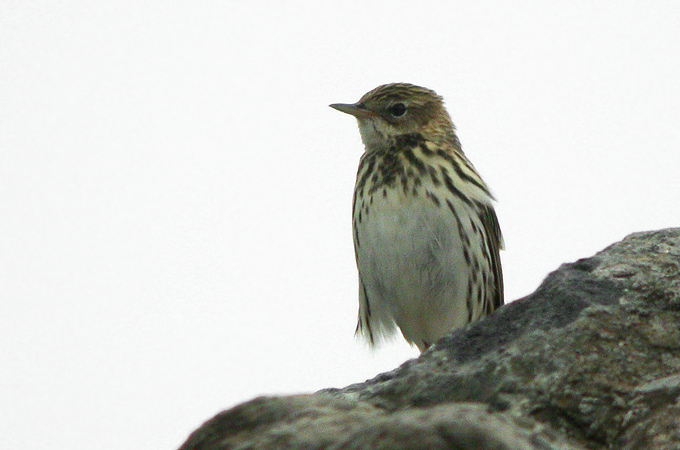
Seotal Oreum, Jeju island, May 25
Two Oriental Dollarbirds and two noisy Black-naped Orioles were Jeju firsts for me, and a familiar sign of summer in Korea. A half dozen Japanese Bush Warblers, and a similar number of Arctic Warblers actively worked the trees and bushes. Several Dark-sided Flycatchers and about a dozen Asian Brown Flycatchers fed from open perches. A Peregrine Falcon circled overhead for a while, prompting alarm calls from the passerines. In the surrounding fields, numerous singing Meadow Bunting and Far Eastern Skylark could be heard.
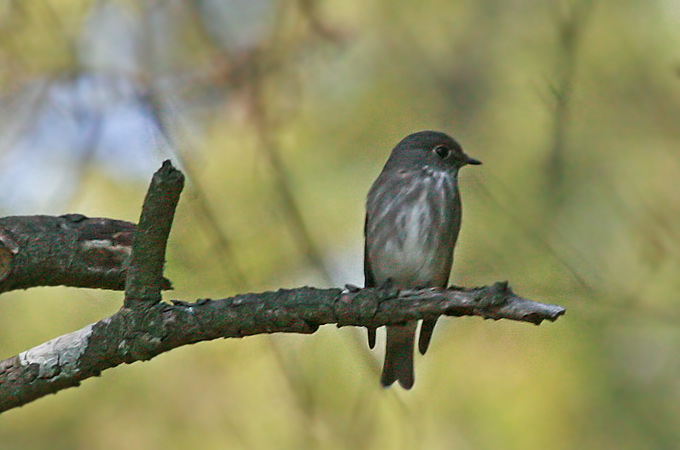
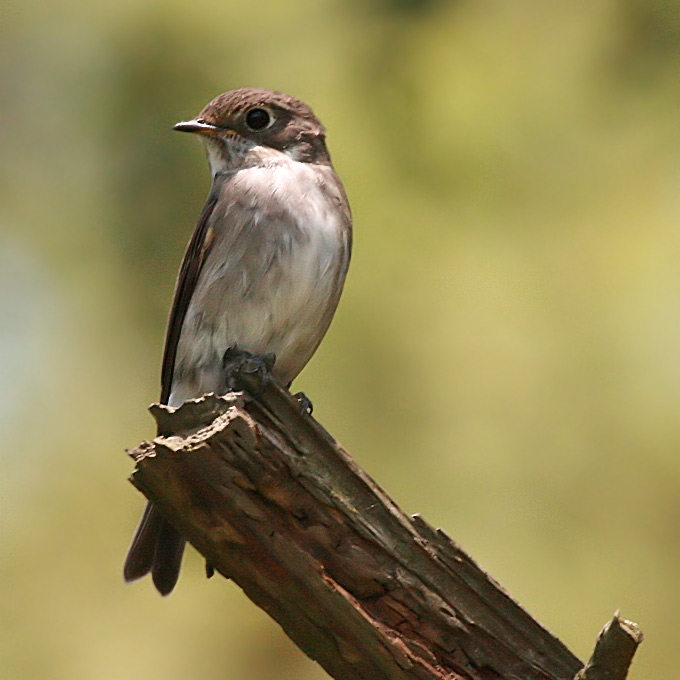
Gageo Island, May 24
In bright sunshine with light to moderate northerlies, reduced numbers of most species, though still 66 species logged during the morning 1-Gu circuit. Species of note included at least 4 Gray’s Grasshopper Warbler (one perched in the open on the fence motionless for 20 seconds or more - too close to try to digiscope!), a Blyth’s Pipit (flushed by walkers, after which it headed west out to sea), two Two-barred Greenish Warbler, a Northern House Martin and the female Citrine Wagtail still, a male Shrenk’s Bittern and best of all a Black Bittern which came in over the pass, flew over the harbor, and crossed the mountain ridge (either to continue south-west, back to China, or to pitch down in cover unseen).
Socheong island, May 21 - 24
The morning ferry, through fog, rain and medium-high waves, yielded few birds: 4 Common Terns, 3 Streaked Shearwaters, a single Ancient Murrelet and an unidentified Loon.
Rain fell softly through the afternoon of the 21st. No large numbers in evidence: highlights were about 12 Arctic, 6 Radde’s, 2 Dusky, 2 Two-barred Greenish, 1 Korean Bush and a few calling Yellow-browed and Eastern Crowned Warblers. Also noted: a single Ashy Minivet, a Rufous-tailed Robin, a Siberian Blue Robin, a Grey-faced Buzzard, 2 Hobbies, a Chinese Pond Heron, a Striated Heron, several Chinese Sparrowhawks, 2 Mugimaki, 10 Asian Brown, 2 Dark-sided, 8 Grey-streaked and 1 Taiga Flycatcher, a Black Drongo, calling Common, Oriental and Indian Cuckoos, a calling Scops Owl, a Pacific Golden Plover, a Black-capped Kingfisher and several Brown Shrikes.
Rain continued through the 22nd, but also lightly; a large part of the day was spent near the lighthouse. Of special note were at least 10 Thick-billed Warblers; these were joined by a Middendorf’s, 6 or 7 Pallas’ Grasshopper, one Lanceolated, 3 more Two-barred Greenish, 50 or so Arctic, 7 or 8 Black-browed Reed, several Oriental Reed, 2 Korean Bush, single Pale-legged Leaf and Eastern Crowned, 20 Radde’s and 9 Dusky Warblers. Several Yellow-breasted Buntings in the area as well as 2 Chestnut-eared and 2 Chestnut Buntings. 2 Yellow-rumped and 2 more Taiga Flycatchers hawked in the pines along with Grey-streaked, Brown and Dark-sides. Also in the pines: Common and Oriental Cuckoos , 5 Chinese Grosbeaks and 4 Daurian Starlings. The walk back to first village yielded a pair of Amur Falcons, calling Chestnut-flanked Whiteyes, another Black Drongo and a White-shouldered Starling. One tree near second village held 9 or 10 Arctic Warblers and a single Japanese Waxwing.
Overcast continued on the 23rd but gave way to sunshine in the late morning. At the lighthouse in the morning, highlights were a passage of 12 Oriental Honey Buzzards, 11 Pacific Swifts and, best of all, a Spotted Dove - doubtless the same individual found by N.M. several days before. One tree held 4 species of starling: the Daurians, the (or possibly a different) White-shouldered, a Red-billed and a Chestnut-cheeked. Locustella warblers seemed much reduced but Brown Shrikes the opposite - about 40 in the immediate area and near 60 for the day. One Rubythroat made a welcome and vociferous appearance. As the day wore on, a clear-out seemed to take place; the walk back and around to the north of the island was remarkably quiet, with a singing Little Cuckoo, reduced numbers of Radde’s and Arctic Warblers, a single Eye-browed Thrush, a few Olive-backed Pipits, another Black Drongo and a Meadow Bunting.
The morning of the 24th was extremely quiet: very few birds around and no new species noted. The return ferry ride was more of the same: a single Streaked Shearwater and, well out to sea, various passage passerines: a Yellow-rumped Flycatcher, Yellow-breasted Bunting, several Barn Swallows, a couple of unidentified Pipits and a Brown Shrike.
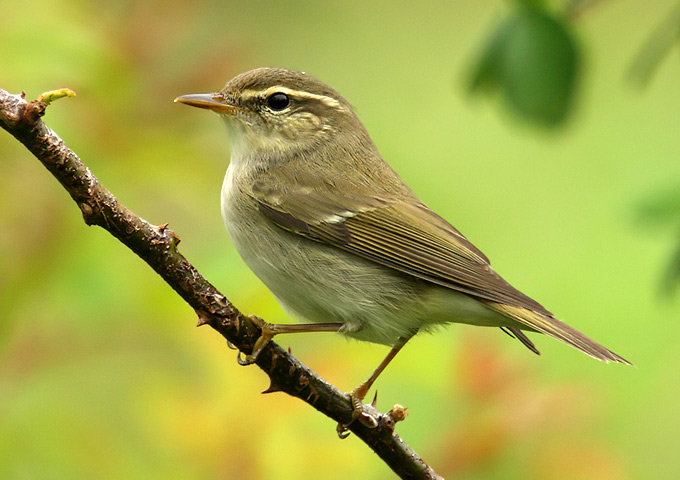
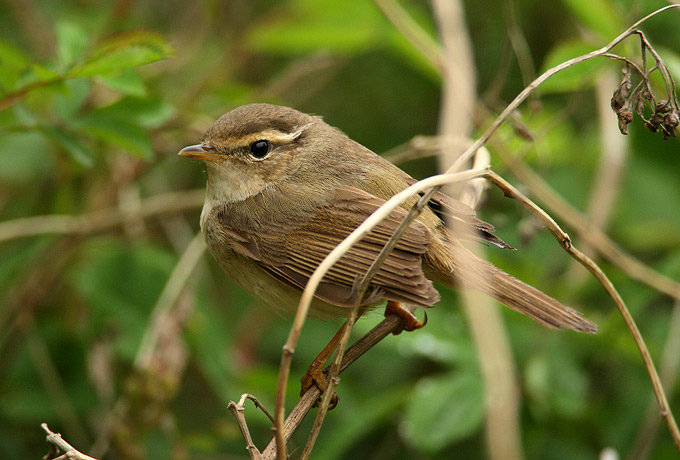
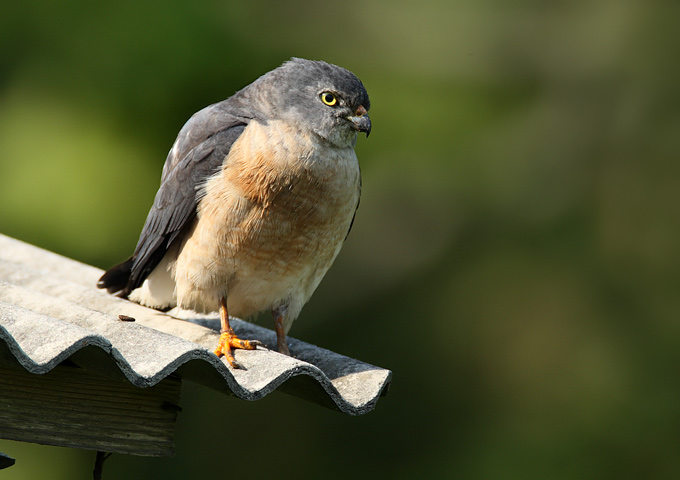
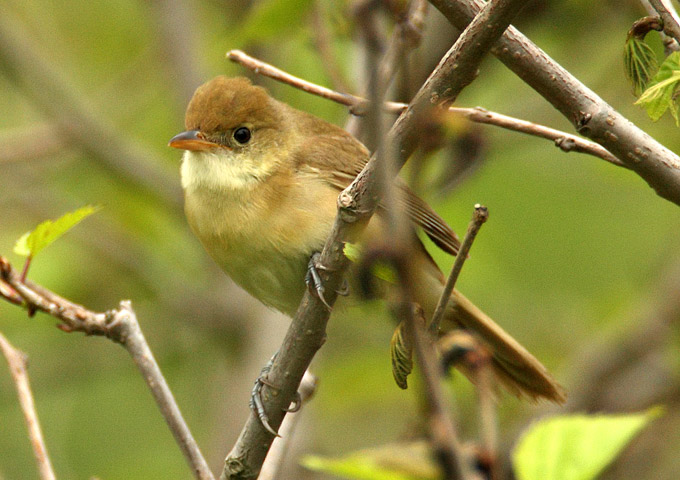
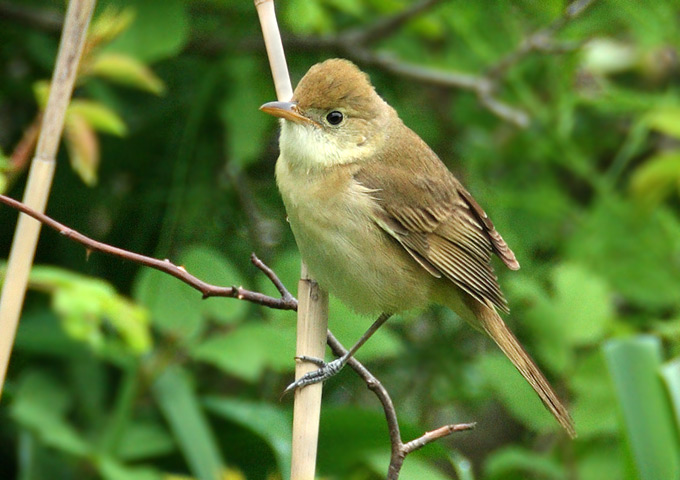

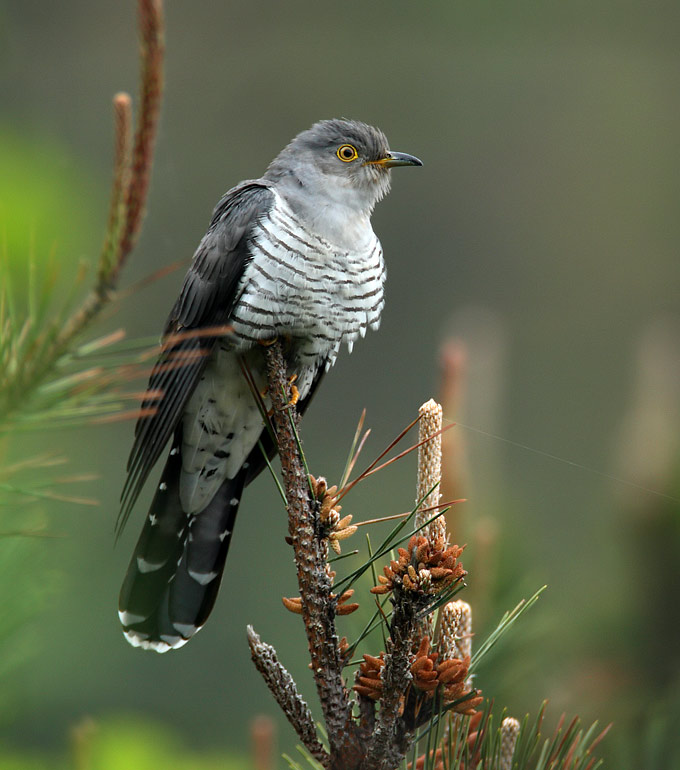
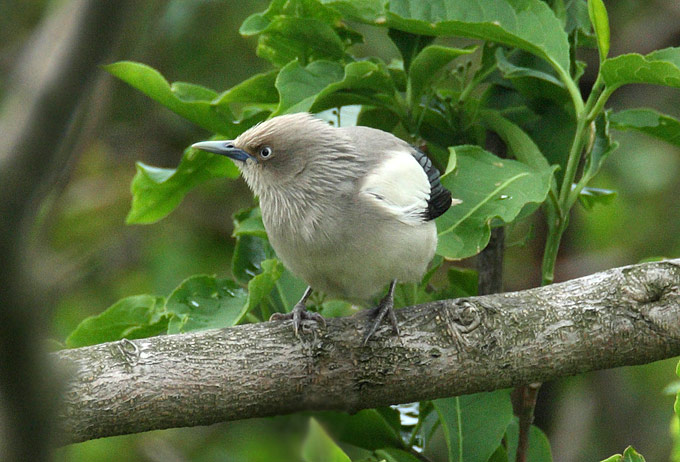
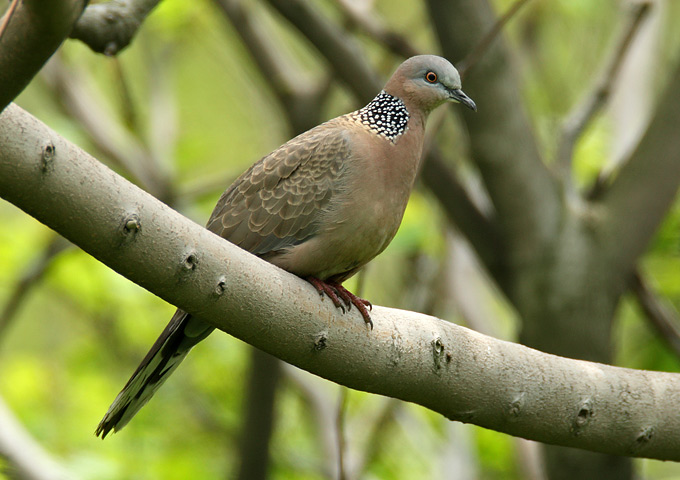
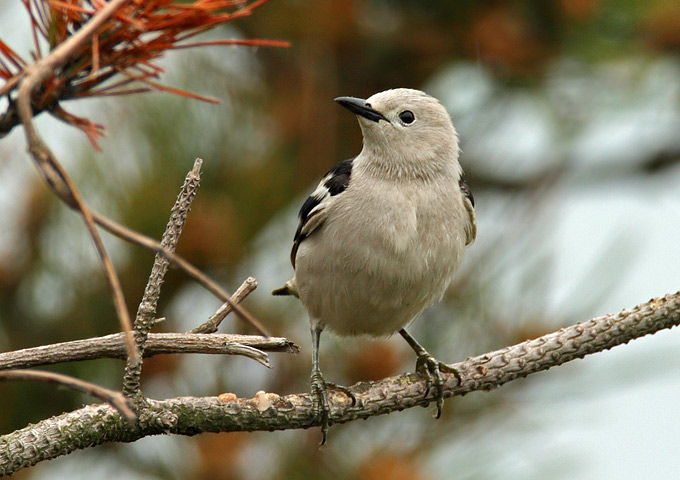
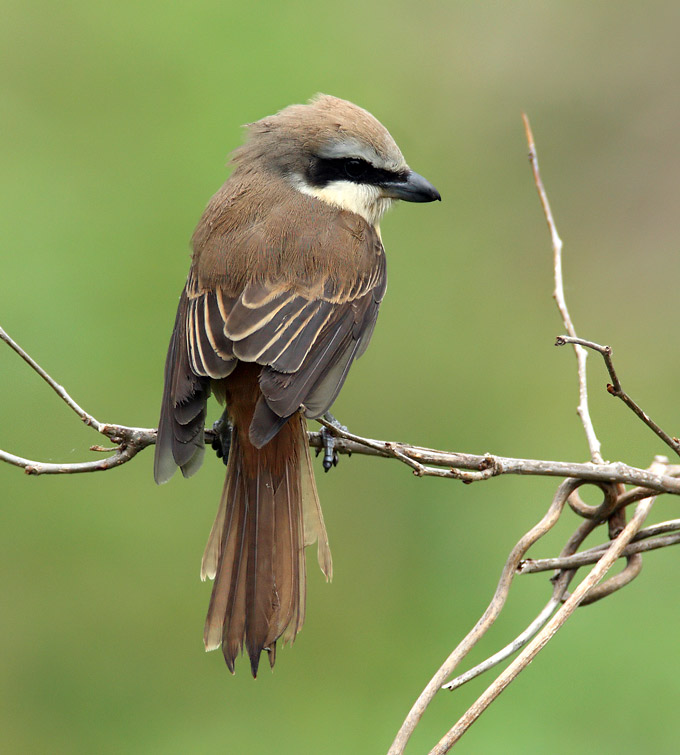
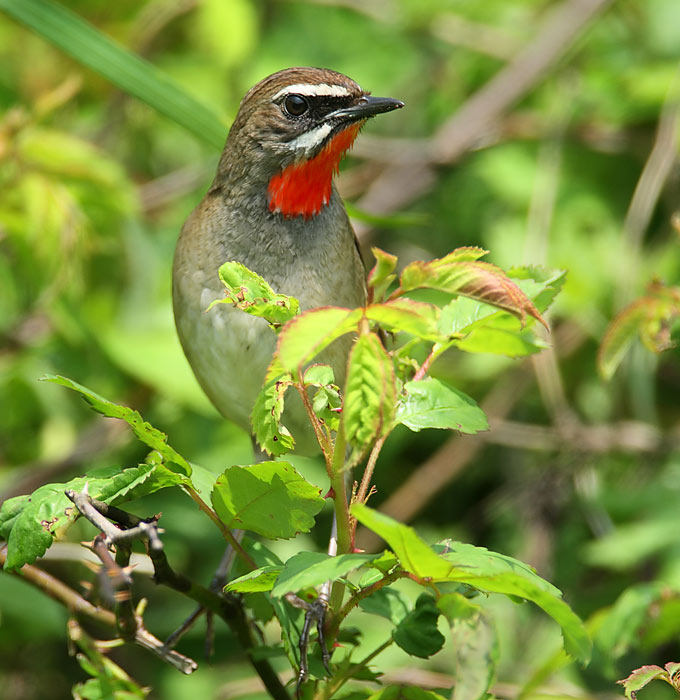
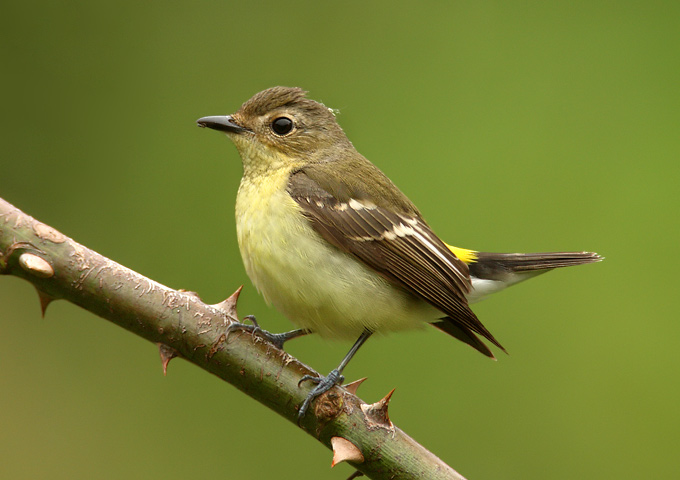
Yanggu, x river and riparian area, May 24
As often as I go bird watching along the river in Yanggu, it still manages to surprise me on a regular basis. Yesterday, as I was walking along the river, not really seriously birdwatching, I saw the Chinese Pond Heron again. Then today when I was seriously birdwatching, I was surprised to see a Purple Heron in the same area. It's the first time I have seen this species in Korea. It was a very wary bird, so it was difficult to get photographs of it, even with digiscope. The chestnut down each side of its neck easily distiguished it from the many Grey Herons.
There were also Grey Herons, Eastern Great Egrets, Great Egrets and Striated Herons. there were Spot-billed Ducks, Mandarin Drakes, Common Sandpipers and Japanese Wagtails along the river as well. In the freshly planted rice fields over the river flood bank I saw Long-billed Plovers, Little Ringed Plovers and Oriental Turtle Doves. In the riparian vegetation beside the river I saw lots of Oriental Reed Warblers, Siberian Stonechats, Common Pheasants, Vinous-throated Parrotbills and a Black-browed Reed Warbler.
It was interesting to see a pair of Daurian Redstarts catching insects and feeding them to there 2 newly fledged chicks on Friday evening, May 22. Black-naped Orioles, Dollarbirds, Indian Cuckoos and Common Cuckoos have been quite vocal this week. I've also heard a Grey Nightjar calling at night.
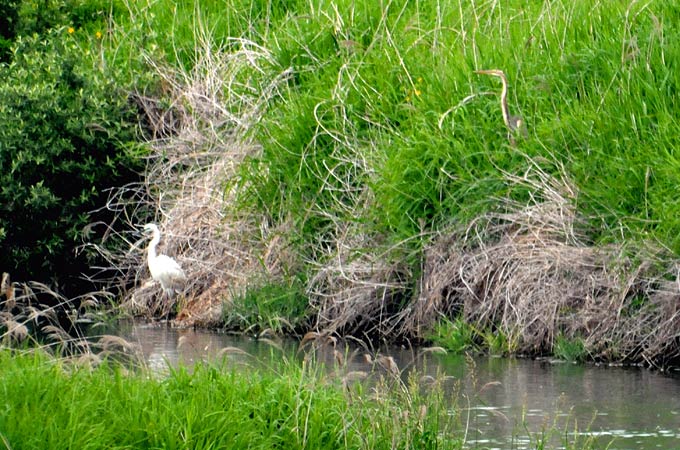
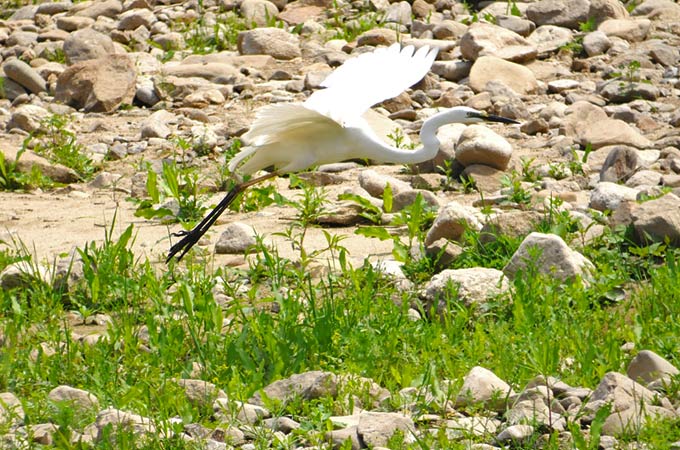
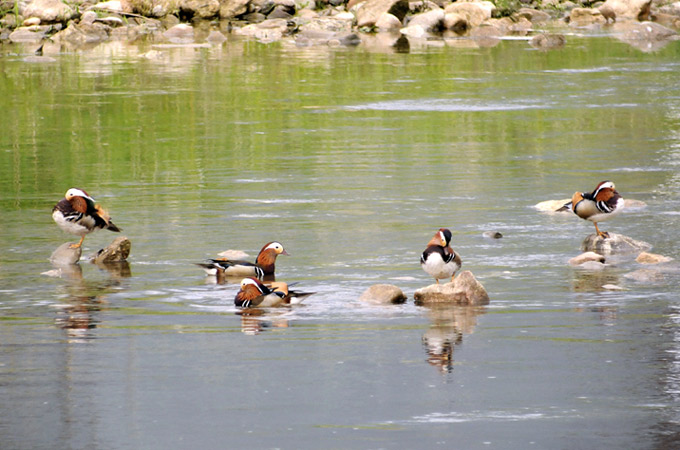
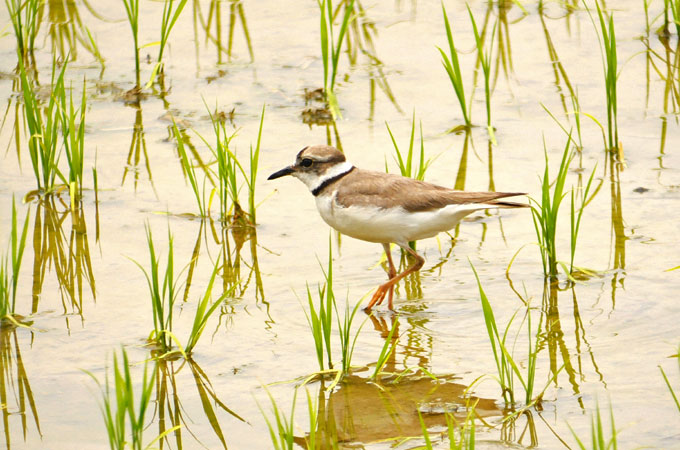

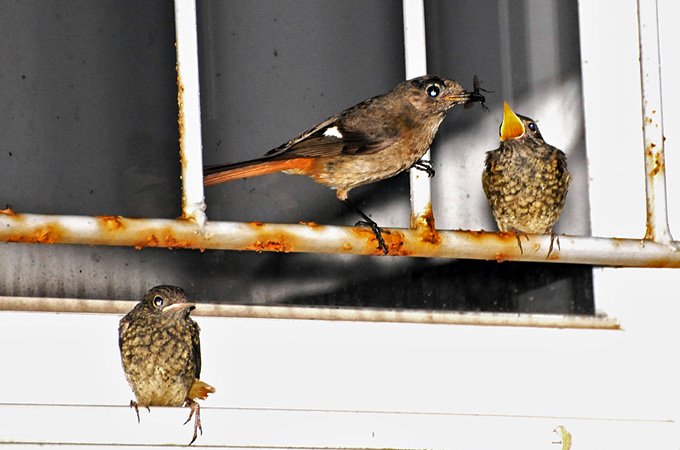
Dongmak/Aham-do, May 23
At Aham-do, most surprising, good views of 2 Curlew Sandpiper, in deep-red breeding plumage. On the golf course, a Brown Shrike. Best at Songdo apparently 7 Black-faced Spoonbill nests and some 12 breeding pairs of Mongolian Gull, both species with chicks.
Quite a scattering of waders at Aham-do, with c. 25 Grey-tailed Tattler, 10+ Ruddy Turnstone, a breeding-plumaged Broad-billed Sandpiper, c. 120 Grey Plover, 60 Dunlin, 20+ Mongolian Plover, 5 Great Knot, 1 Spotted Redshank, a Marsh Sandpiper, Several Common Greenshank and Kentish Plover, 5 Eastern Oystercatcher, c.40 Bar-tailed Godwit, 1 Red-necked Stint, c.20 Terek Sandpiper, 2 Intermediate Egret,and patrolling Little Tern and Saunders's Gulls. The long-taying Coot and 2 Moorhen are on the lagoon: Also on the golf course, 4 Asian Brown Flycatcher, a Common Cuckoo and 5 Arctic Warbler.
Gageo Island, May 23
Clear skies late on 22nd, clouding-over during the night, followed by heavy early morning drizzle, and then sunny skies again - all in a weather system moving west away from the Chinese coast - created a really excellent late spring day, with at least 94 species logged in 1-Gu and 2-Gu. Among many highlights the standouts were: Two Cinnamon Bittern, with a male in the quarry (flying out from dense vegetation within a couple of metres of a Gray's Grasshopper Warbler in sub-song, to perch largely hidden and viewable only at 250 m distance) and a female flying up the "Slope", before disappearing into thick cover; a drongo sp. (on the very brief views had, almost certainly a Hair-crested); two Northern House Martin (these late in the afternoon, mixed in with a flock of 480 Pacific Swift - easily the biggest swift flock so far this spring); two Citrine Wagtail (with the "regular" female, and a new, dark-capped male); two Watercock; and two White-breasted Waterhen (at the Tip); and one or two Light-vented Bulbul. Species of special conservation concern included 3 Chinese Egret (Vulnerable), eight Black Woodpigeon (Near-threatened), three or more singing Styan's Grasshopper Warbler (Vulnerable), two Yellow-breasted Bunting (Vulnerable) and a very late Yellow Bunting (Vulnerable), while more numerous species during the day included Chinese Sparrowhawk (with a single kettle of 160, also containing single Crested Honey Buzzard and Grey-faced Buzzard) , Eastern Cattle Egret (80) and Eye-browed Thrush (a flock of 50 in the morning). Further species of note (!) included the same or another Black Kite, at least 10 Oriental Dollarbird and 14 Brown Shrike, a flock of at least 10 Pechora Pipit (with 7 further noted during the day), very late (single) Dusky Thrush and Yellow-throated Bunting, and single adult male Red-billed and Chestnut-cheeked Starlings to round off the day at 2-Gu.
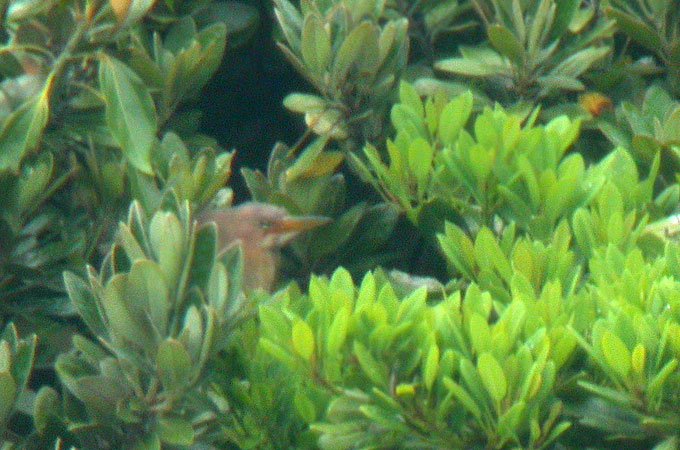
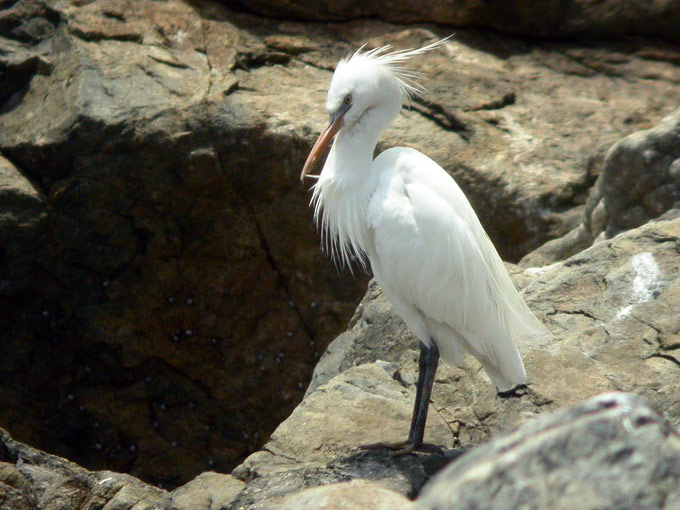
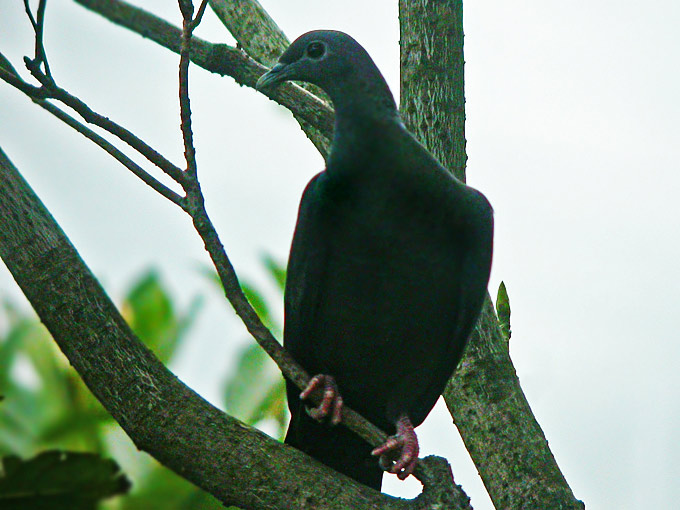
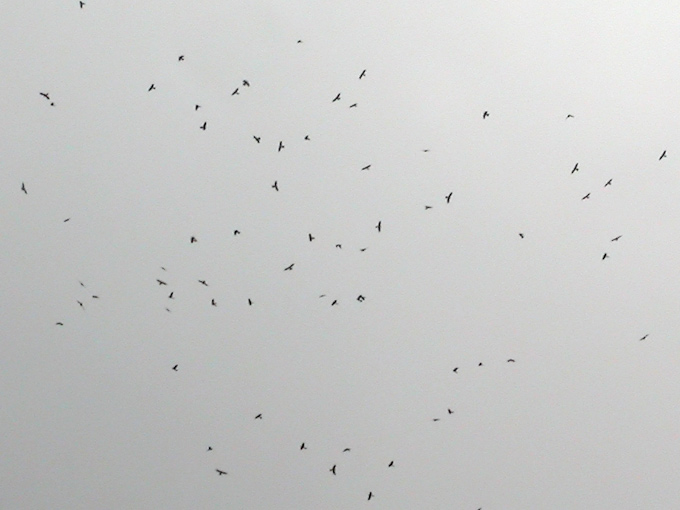
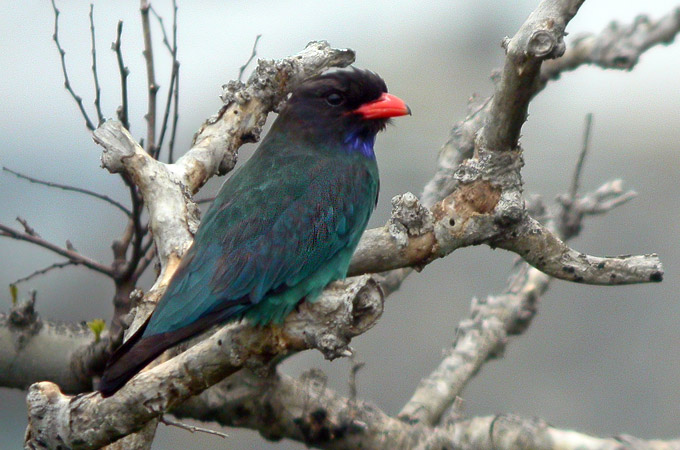
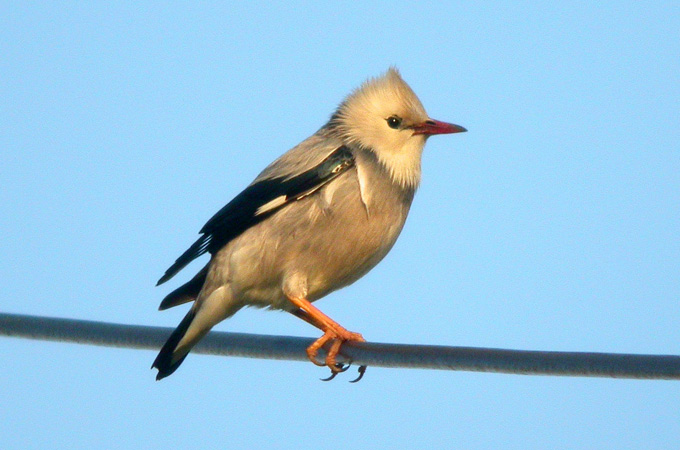
Gageo Island, May 22
With clear skies and only a moderate westerly wind, rather more birds were in evidence, and a total of 70 species were logged during the day. In 1-Gu, species of most note included two Citrine Wagtail (both the male from the 20th and the female), two new-in Sharp-tailed Sandpiper and the Broad-billed Sandpiper still, a female Thick-billed Shrike, at least 3 Pallas’s and 17 Middendorff’s Grasshopper Warblers, 4+ female Siberian Rubythroat, and the Black Kite still. At the Pass, a loose flock of 10 cuckoo (presumably almost all/all Common Cuckoo), and at 2-Gu, highlights included another Thick-billed Shrike, a superciliosus Brown Shrike (reported scarcely annually in Korea), and a second calendar year male Amur Falcon.
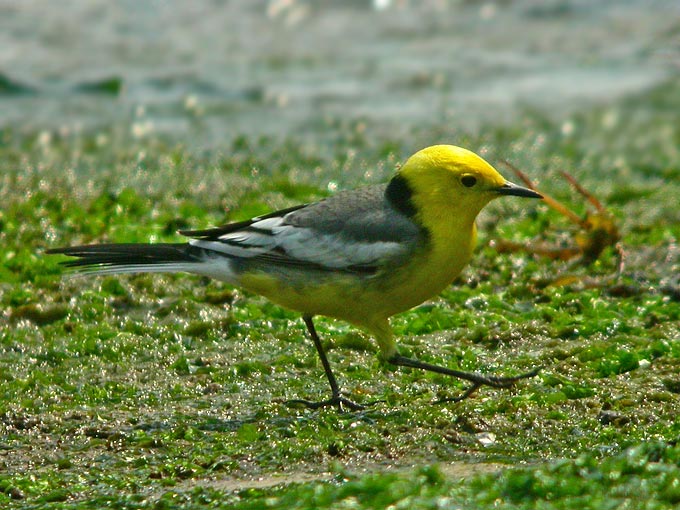
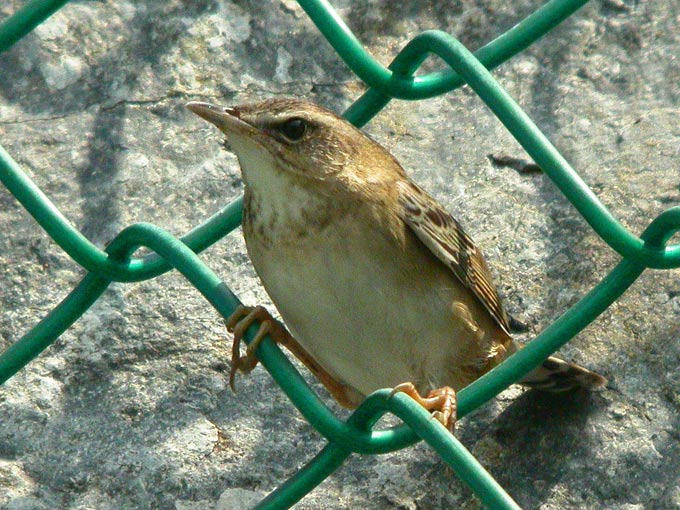
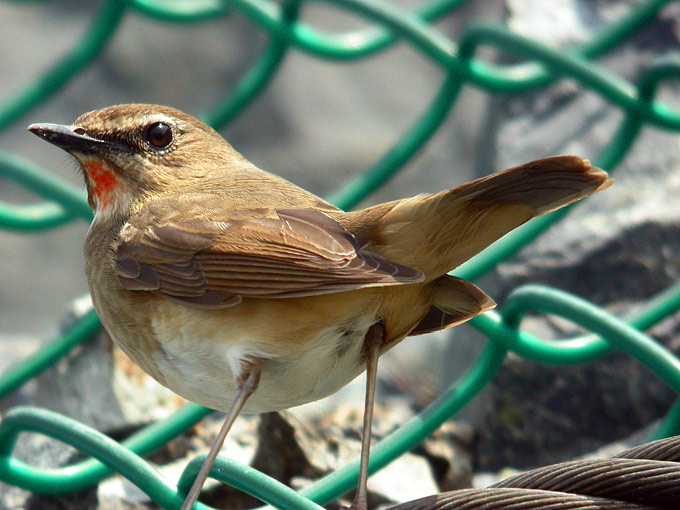
Gageo Island, May 21
With heavy rain overnight continuing until 10 AM, followed by overcast conditions, there was high anticipation of a major arrival of birds. However, perhaps because of strong, even gusting gale-force, westerlies 1-Gu was for the most part eerily quiet, with a total of only 41 species and 135 birds during the afternoon, with most numerous among these Eastern Cattle Egret (30) . Despite this, three species of especial note were logged: the female Citrine Wagtail still, a Black Kite, and best of all a very briefly seen (and heard!) Band-bellied Crake.
Gageo Island, May 20
The ferry journey from Mokpo was again rather uneventful, with among the “best” being (just) three Common Tern. On Gageo, a few hours ahead of forecast rain only a small number of birds in 1-Gu (e.g. only one Yellow-browed and three Arctic Warblers), but still good diversity with 62 species logged. Birds of most note included a Broad-billed Sandpiper on the “beach”, 3 White-breasted Waterhen, single Blyth's and 4 Pechora Pipits, the personal first Yellow Bittern, Middendorff''s and (probable) Styan's Grasshopper Warblers of the spring, and two Citrine Wagtail - one a brilliantly plumaged adult male, sadly seen only from afar as it was chased off the “beach” by a highly agressive female.
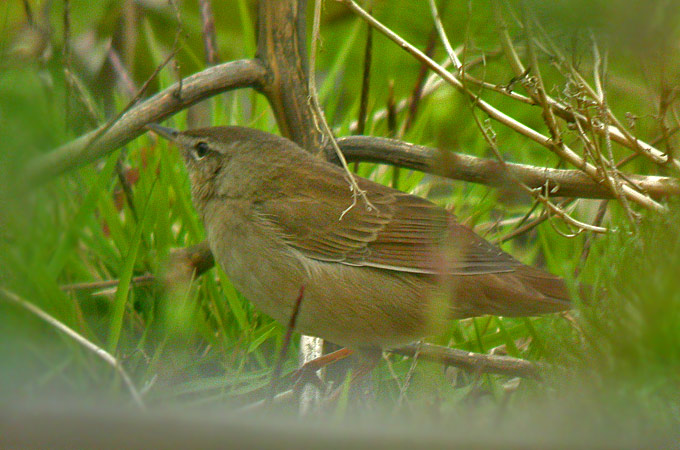
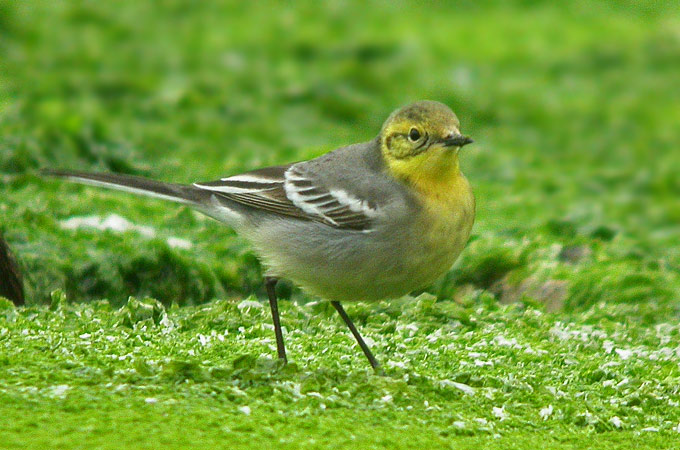
Socheong Island, May 18
With clear skies and strong westerly winds, evidence of a major clear out of birds. Highlights during the morning included half-a-dozen Siberian Thrush, a close encounter with a stunning adult male Bluethroat at the lighthouse, at least 8 Light-vented Bulbul, and what appears to be a (late-plumaged second calendar year male?) pandoo Blue Rock Thrush - if so, only the fourth or so national record of this subspecies.
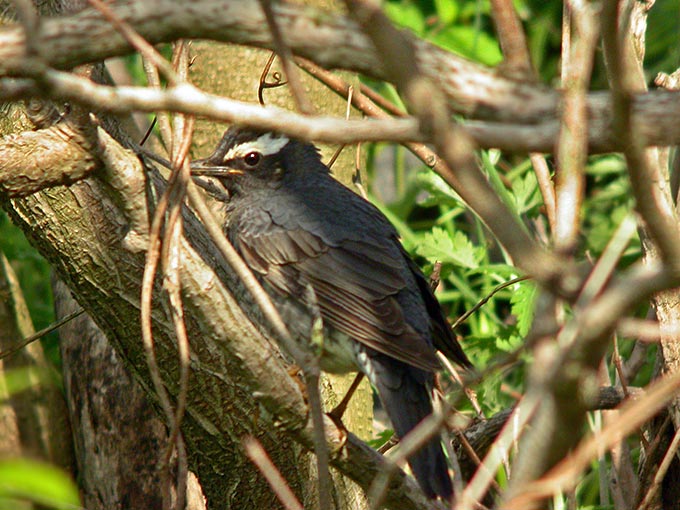
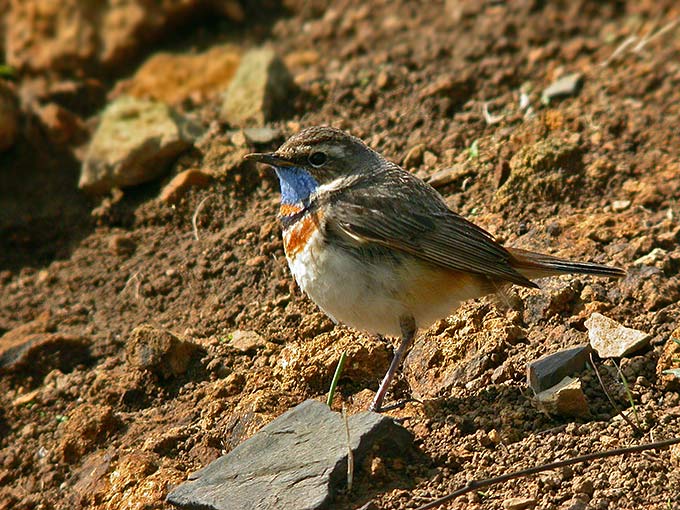
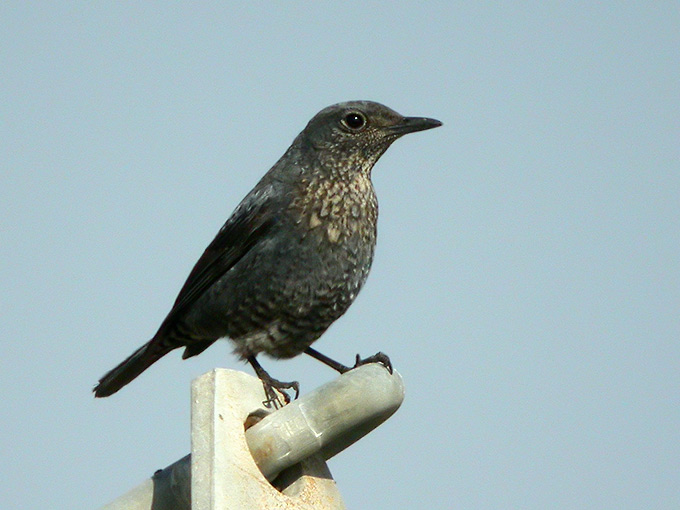
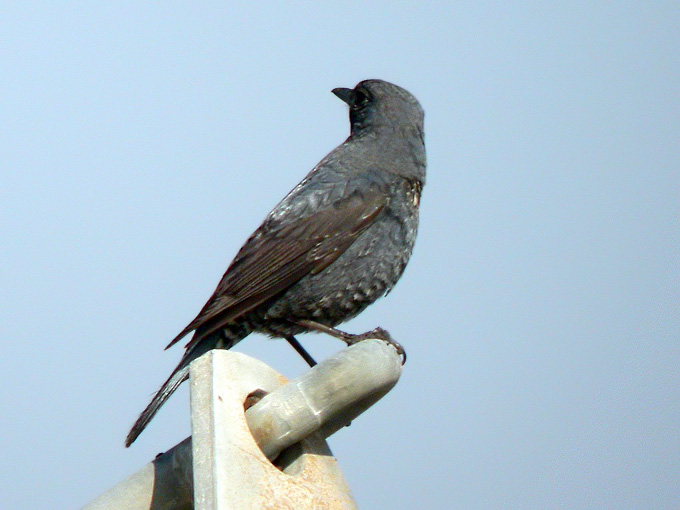
East coast, Jeju island, May 18
Along several beaches near Seongsan, 2 Red-necked Stint, 10 Dunlin, and 1 Kentish Plover were seen.
Several Grey-tailed Tattler and Common Sandpiper associated nearby, and a Common Cuckoo was also heard.
At Pyeoson beach, 4 Great Knot paced the beach, and 5 Whimbrel flew overhead. Nearby, a Little Ringed Plover performed broken wing displays, while about about 6 Oriental Reed Warblers noisly moved through a reedbed.
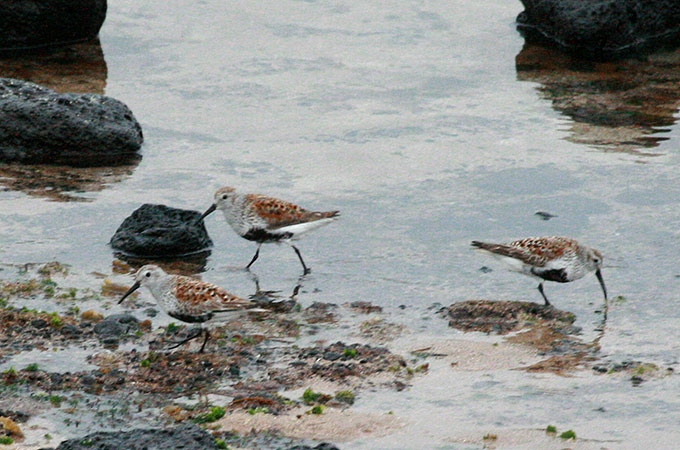
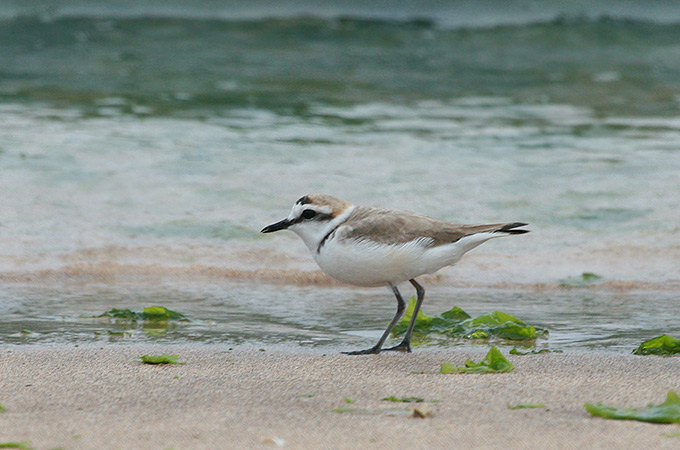
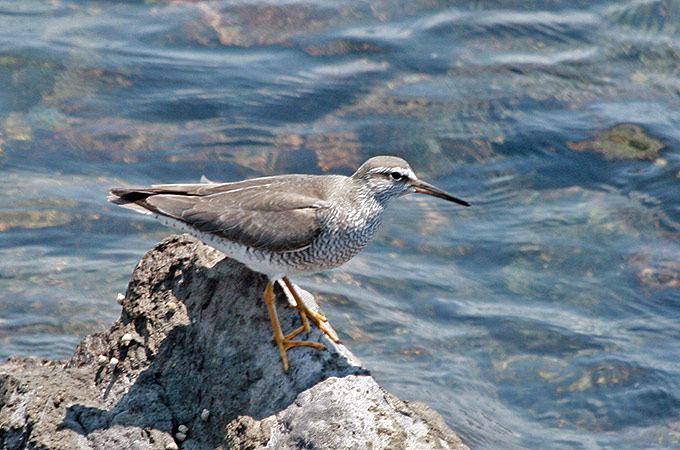
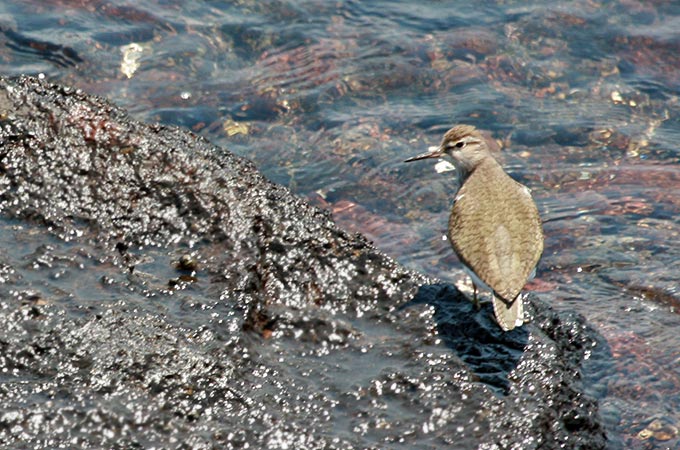
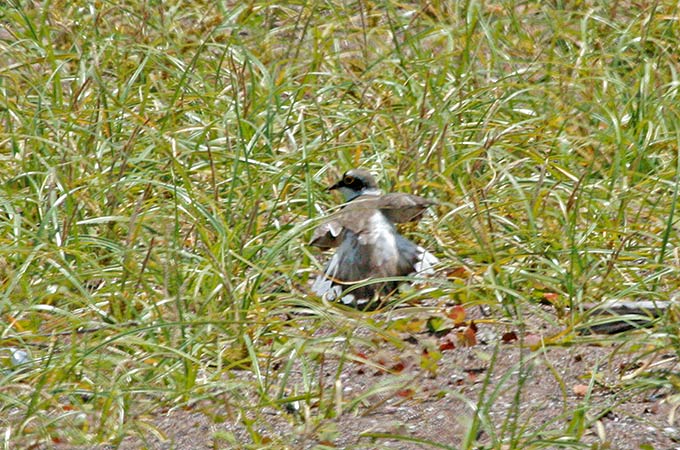
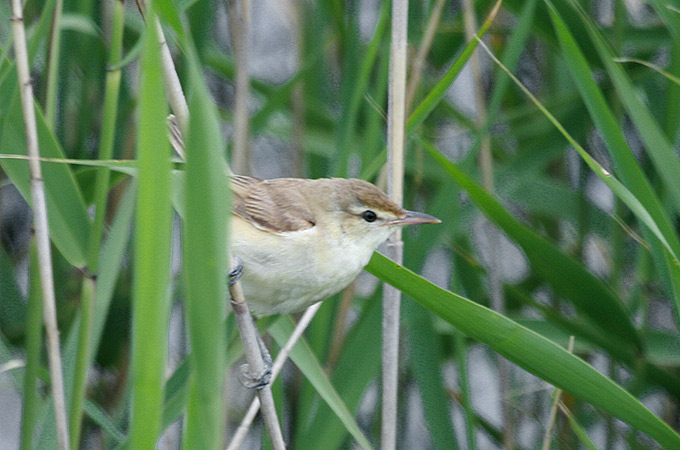
Yanggu and East Coast Lagoons, May 18
On Thursday May 14 I walked along the river in Yanggu. It was a good day to see Sandpipers with Green, Wood and Common Sandpipers present. Beside the river there were Oriental Reed Warblers, Siberian Stonechats, Black-faced Buntings and Common Pheasants. Several males of the latter species were seen strutting aound and heard calling.
I surveyed the birds along Namdae Cheon on Sunday May 17. In the morning incool windy weather with light rain I found about 10 Little Terns, Grey Herons, Spot-billed Ducks, a female Common Merganserand Black-headed Gulls on the sandbar by the sea. I saw more than 20 Common Sandpipers beside the floodbanks in the lower reaches of the river. Upstream towards Yangyang there were lots of Oriental Reed Warblers, two Female Buntings, Pallas's Reed Buntings, Grey-headed Buntings, Siberian Stonechats, a Zitting Cisticola, 2 Dusky Thrushes and numerous Common Pheasants. I saw a Common Greenshank fly upstream along the river. A Hoopoe flew over carrying some food in its beak. I also saw a pair of Common Teal, a Coot and a Moorhen.
I finer conditions in Sokchoon Cheongcho Lagoon on May 17 there was still one Mallard, 6 Spot-billed Ducks, 17 Grey Herons, 2 Eastern Great Egrets, a Little Egret, more than 52 Black-tailed Gulls, a Little Ringed Plover, 14 Grey-tailed Tattlers, 16 Common Sandpipers, a Little Grebeand a Red-necked Grebe.
After a rainy Saturday, I had a good day of birding on Sunday.
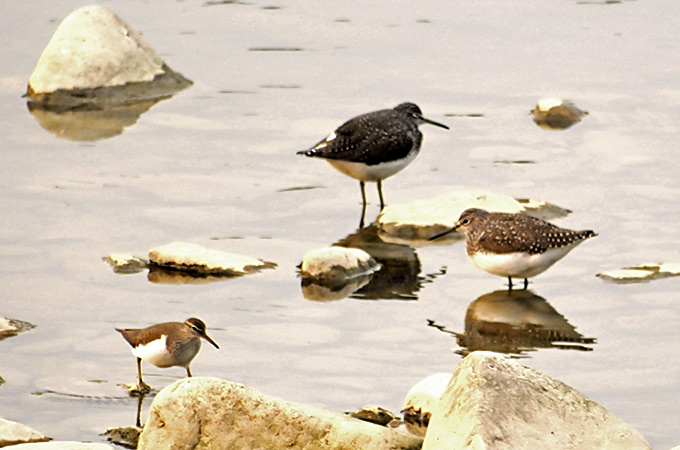
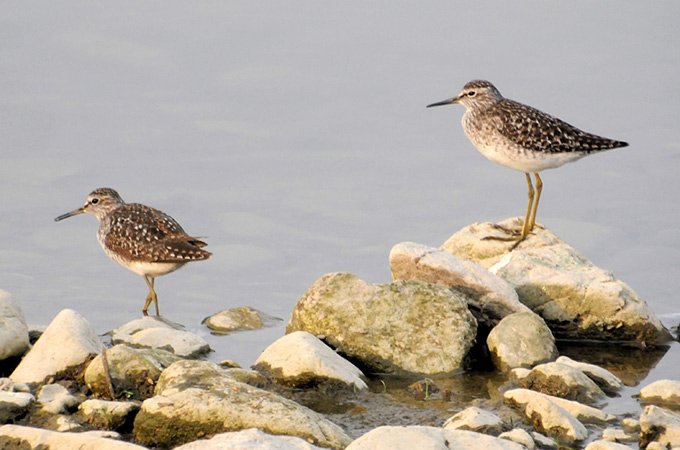
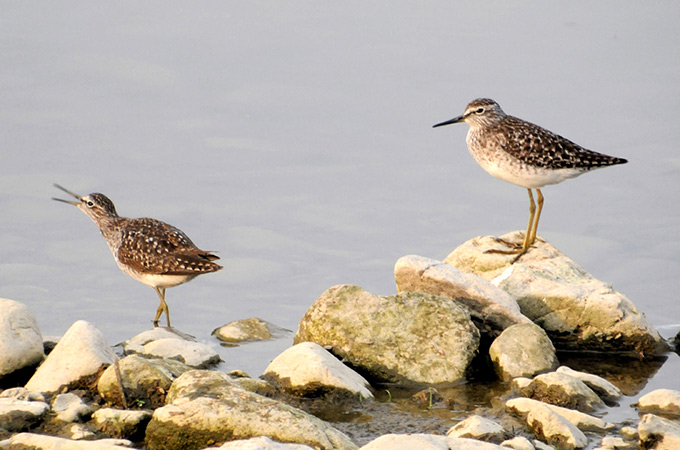

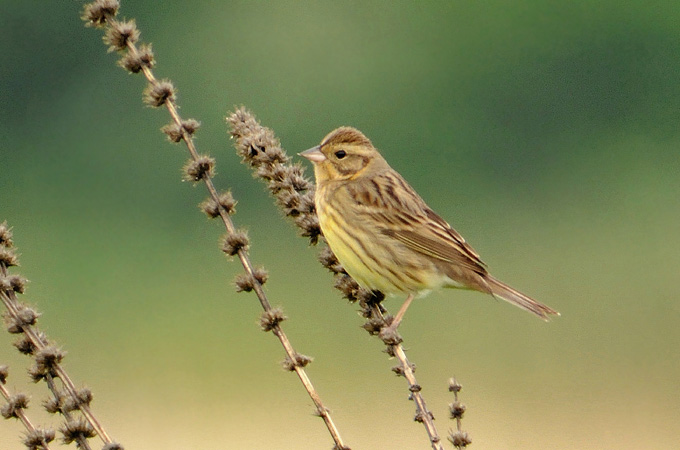
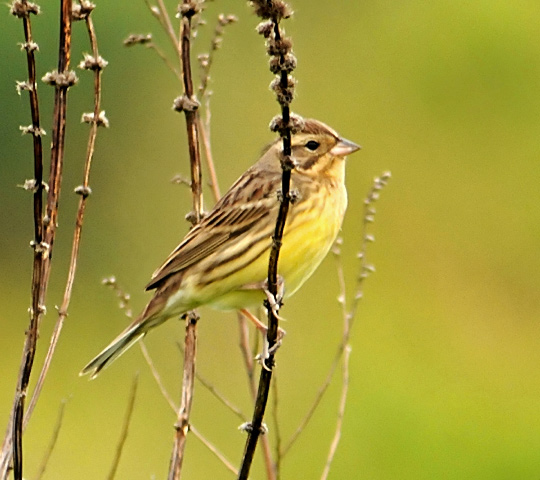
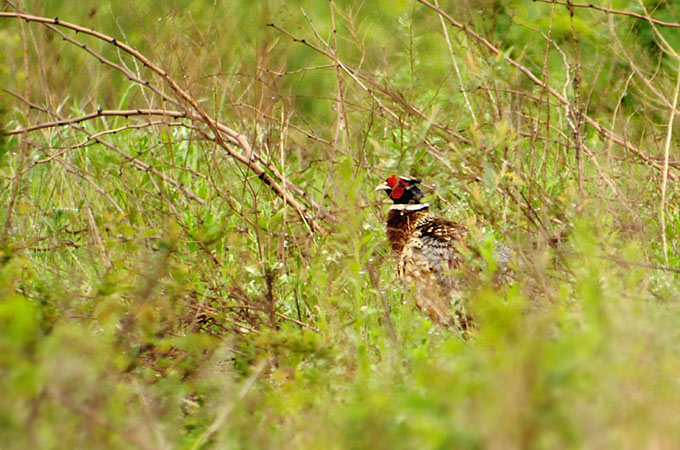
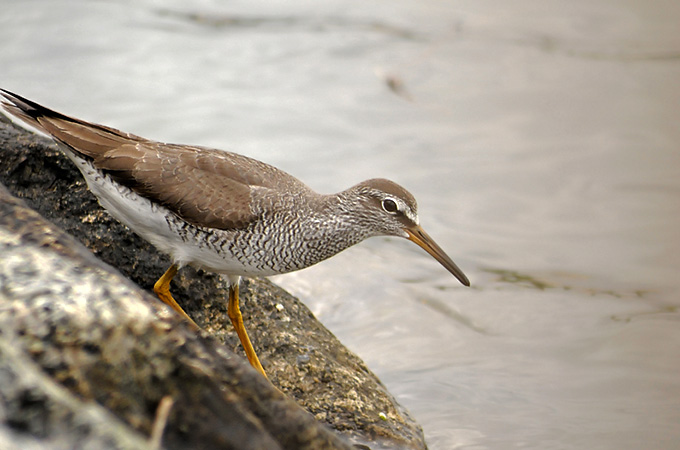
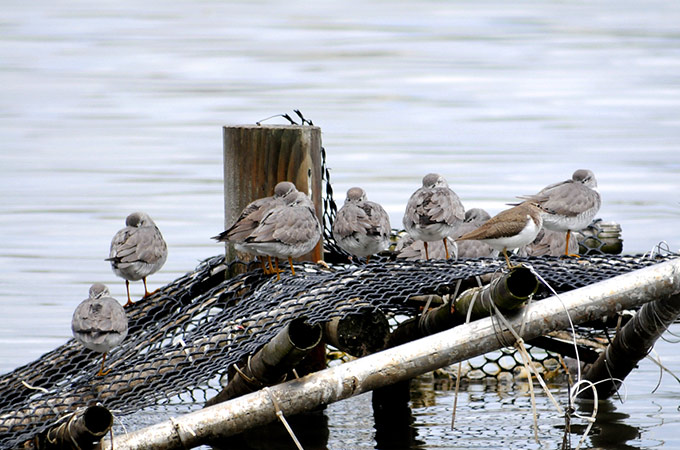
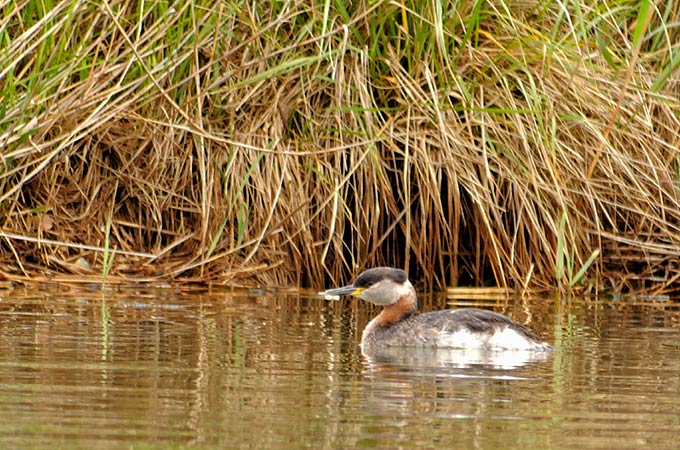
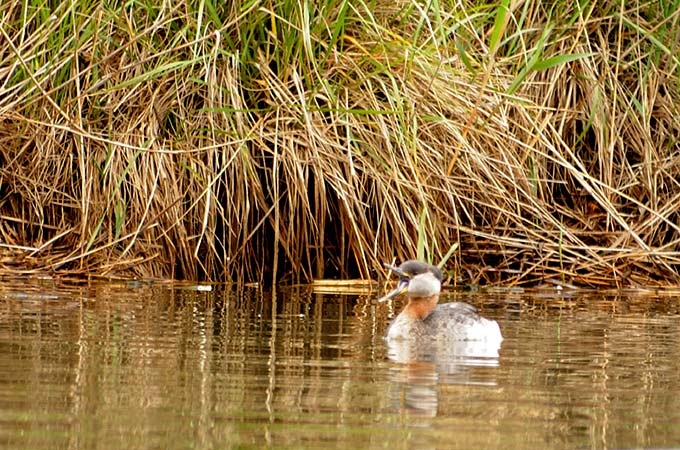
Socheong Island, May 17
Another overcast and drizzly night, followed by fog banks and then clear sunshine - perfect conditions for major movement of birds on Socheong. Among the 100 species logged during the day, the most numerous included Eye-browed Thrush (230) and Chestnut Bunting (300), nationally-high counts of 26 Taiga Flycatcher and 78 Brown Shrike, and “other species” including 20 Siberian Thrush seen (and another 10 or so heard), a White-breasted Waterhen and a Ruddy-breasted Crake, and the personal first Thick-billed Shrike (3), Thick-billed Warbler (1), Gray’s (1 or 2) and Pallas’s Grasshopper Warblers (3+) of the spring. The most outstanding highlights were both near the lighthouse: a probable (sadly silent) Yellow-streaked Warbler, and Korea’s second Spotted Dove, found just after it had arrived, feeding and even sleeping on the road!
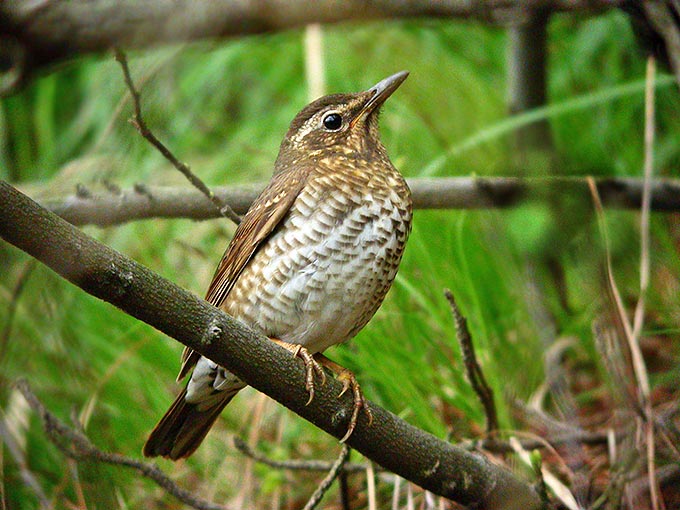
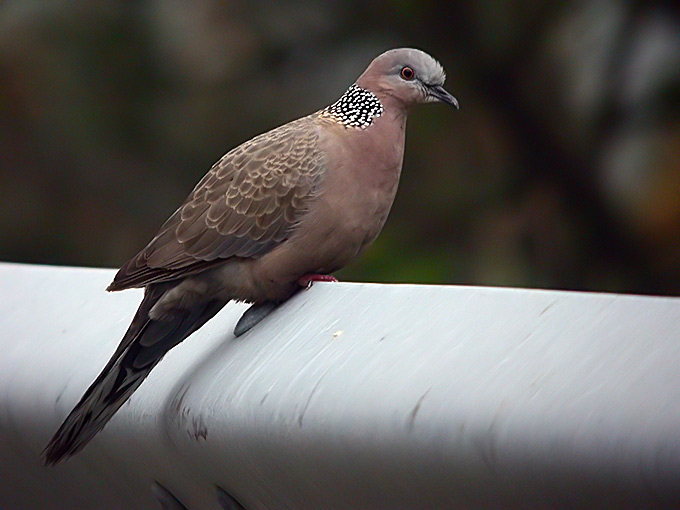
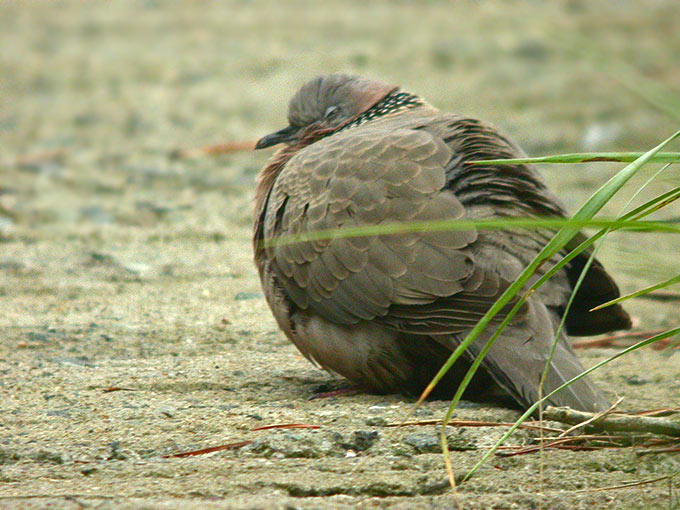
Socheong Island, May 16
Heavy rain until 11AM, followed by occasional showers, heavy overcast, and SE winds. Another very interesting day, with 98 species logged. Highlights included the first decent numbers of Yellow-breasted Bunting of the spring (a still small number, weather conditions considered of 50+), at least 12 Chestnut-eared and 350+ Chestnut Buntings, 16 Taiga Flycatcher, 300+ Eye-browed and 30+ Siberian Thrushes (including a single flock of 15 watched coming in off the sea), at least 3 Brown Shrike with white wing-patches, and a very surprisingly high count of 6400 Streaked Shearwater off the west of the island towards dusk.
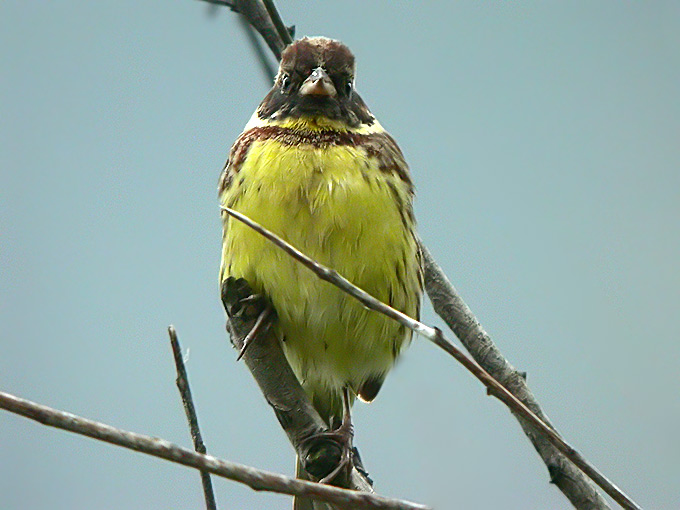
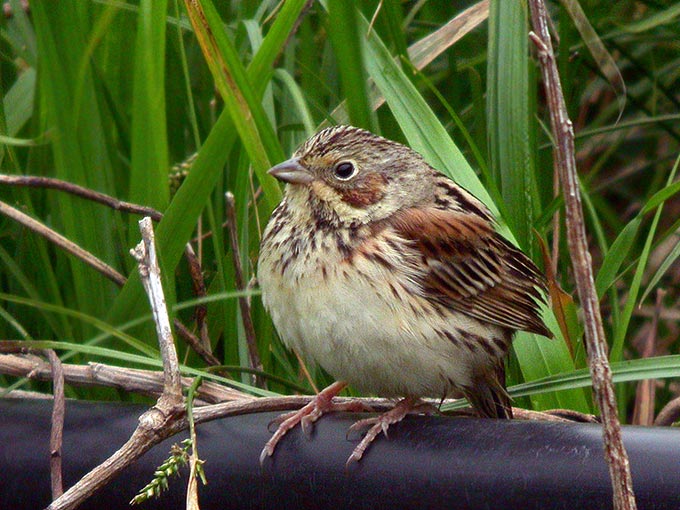

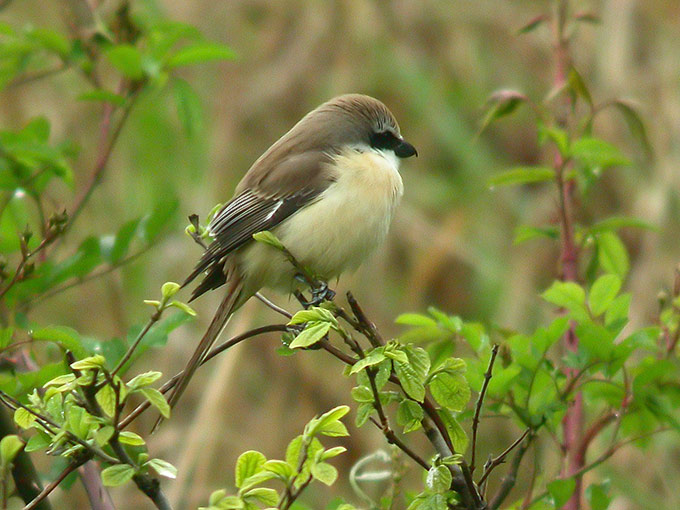
Deokcheok-do, May 15 & 16
May 15: steady rain by the time I got to Deokcheok from Mungapdo - a walk about that evening gleaned calling Common and Indian Cuckoos, a single Brown Shrike, a calling Black-capped Kingfisher, 3 Olive-backed Pipits, a notable 25 Yellow Wagtails on one rice paddy with 5 Grey Wagtails, several Chestnut, Black-faced and Yellow-breasted Buntings, and 2 calling Scops Owls.
The morning of the 16th in heavy rain added a Pacific Golden Plover, a Greenshank and a Common Rosefinch. T.E came on the island later in the morning: he had a Pechora Pipit. Rain continued and boat people predicted it would last through the next day; the boats were still running; we went back to the mainland.
Socheong Island, May 15
With overcast conditions and occasional spots of rain, another new set of arrivals. Amongst the 90 or so species logged during the day, the personal first Dark-sided Flycatcher and Black Drongo of the spring, 5 Light-vented Bulbul (apparently flying in off the sea at the lighthouse), the highest count so far of the spring of Brown Shrike (34, including one with a large white wing-patch) and a Brown-headed Thrush.
Mungap-do, May 14 & 15
My first visit to the attractive island of Mungap-do, population 60.AAs might be expected in advance of a rain system, relatively small numbers of birds. Highlights from the afternoon of the 14th: several Brown Shrikes,2 Hobbies, 3 Eye-browed Thrushes, about 10 Chestnut-flanked Whiteyes, a single Black Drongo, 3 White-throated Needletails, a Rufous-tailed Robin, 2 Cattle and 1 Intermediate Egret, 3 Streaked and 5 Brown Flycatchers, several calling Scops Owls, a Daurian Starling, several calling Black-naped Orioles, several Eastern Crowned, Arctic and a few Yellow-browed Warblers calling, 2 Indian and 3 Common Cuckoos calling, a surprising Yellow Bunting, several Yellow-breasted Buntings, 2 Chestnut-eared Buntings and a few each of Little , Tristram’s, Chestnut and Black-faced Buntings.
The 15th, as rain made its way in: highlights of the Drongo still, 3 Chinese Grosbeaks, a Scaly Thrush, a Yellow-browed Bunting, a Green Sandpiper, a Far-Eastern Oystercatcher, and the season’s first Forest Wagtail.
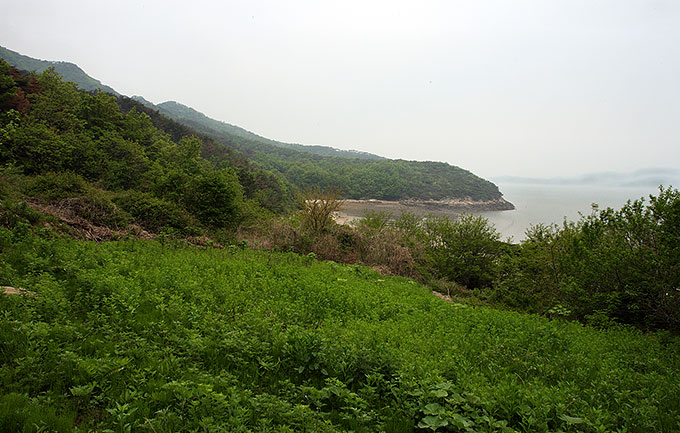
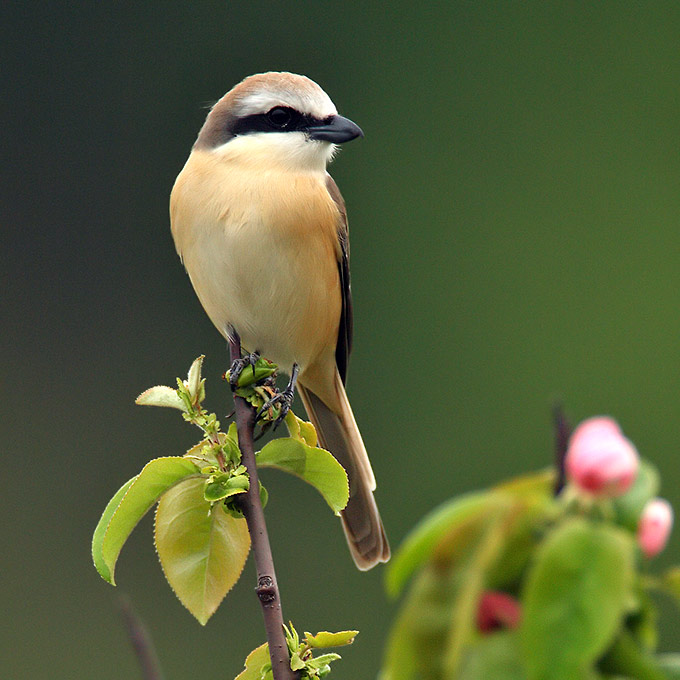
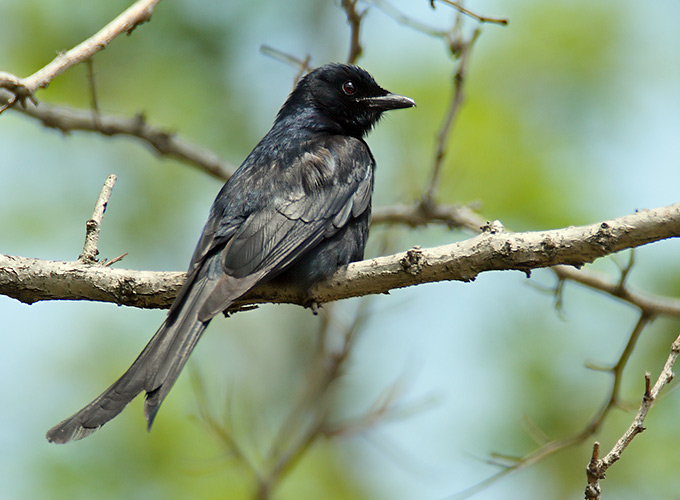
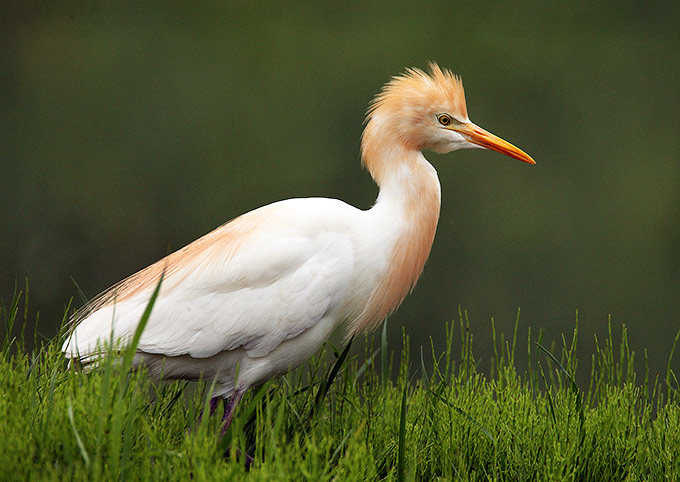
Socheong Island, May 14
With light westerlies, the first decent arrival of Siberian Blue Robin of the spring, with at least 110 logged, and 2 Light-vented Bulbul watched departing northeast from the island from Northeast point (next land- DPRK - where apparently no record of the species yet!). Far less positive, there are now no less than five different construction sites on the island - more than in any previous year of survey work (first in 2003), and mirroring the explosive growth in construction in the last year or so. On Socheong, there is now bulldozing of the once wonderful and drivable track towards NE point to make a concrete road; digging of holes and moving of concrete poles in 1-Gu; continuing (and apparently continuous) harbour extensions in the main harbour; and now recently lain concrete being broken up again to lay new water pipes in the second village. It should be hard for most people to understand how this more or less annual shipping-in of materials (apart from the ever-precious water) as well as of this year several dozen construction workers can be considered part of any long-term or sustainable “Green Development” ethic.
Socheong Island, May 13
A sunny day, with light to moderate north-westerly winds and 89 species logged during the day. Although numbers of most species were down (for example there were only 120 Chestnut Bunting and 25 Eastern Yellow Wagtail remaining), and up to 10 Chinese Sparrowhawk helped keep some birds in cover, highlights still included close encounters with a Grey Nightjar (one of three during the day) briefly sitting in the open before being flushed by a car, the personal first Lanceolated Warbler of the spring, 10+ Mugimaki, 10 Taiga Flycatcher and a briefly heard and even more poorly glimpsed Red-breasted Flycatcher (Socheong’s first spring record), 5 Light-vented Bulbul (the first since mid-April), and the Tickell’s Leaf Warbler again.
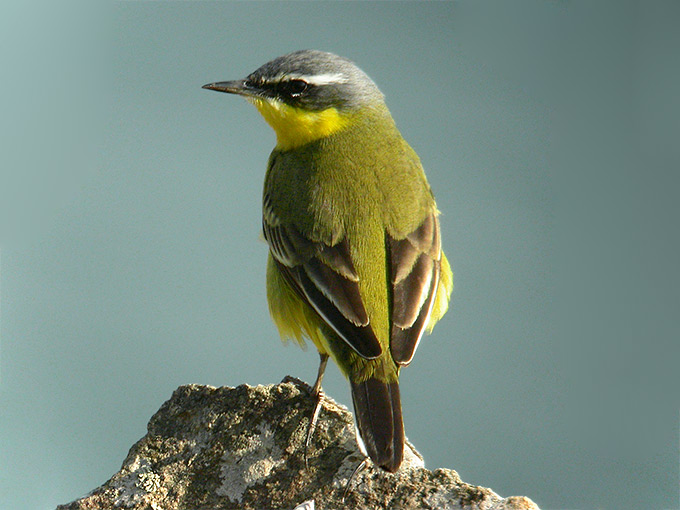
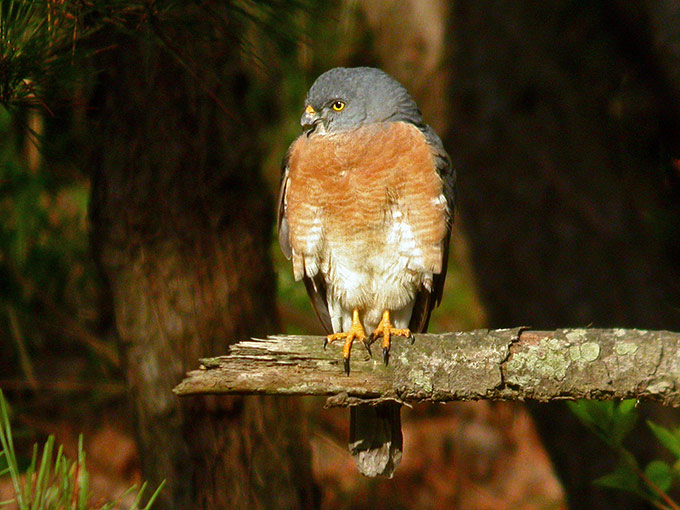
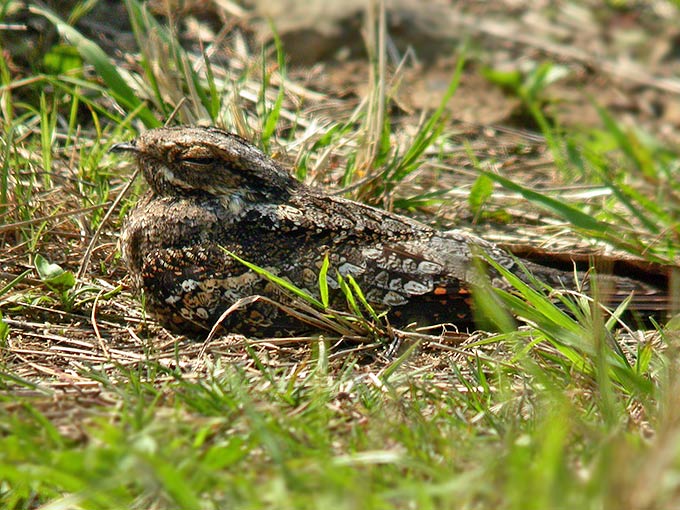
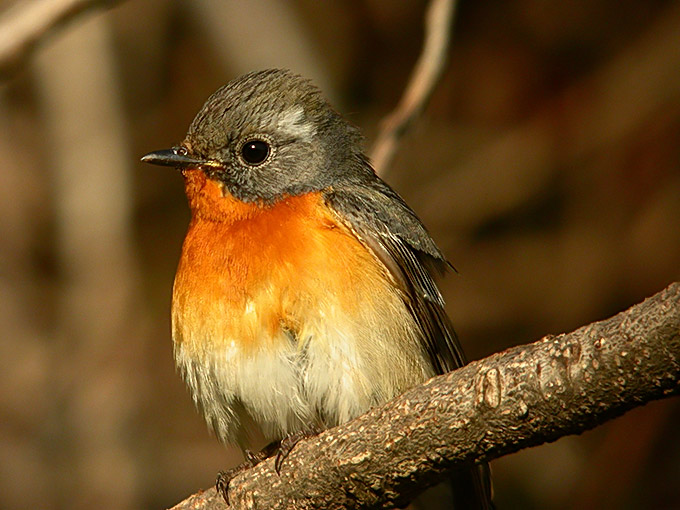
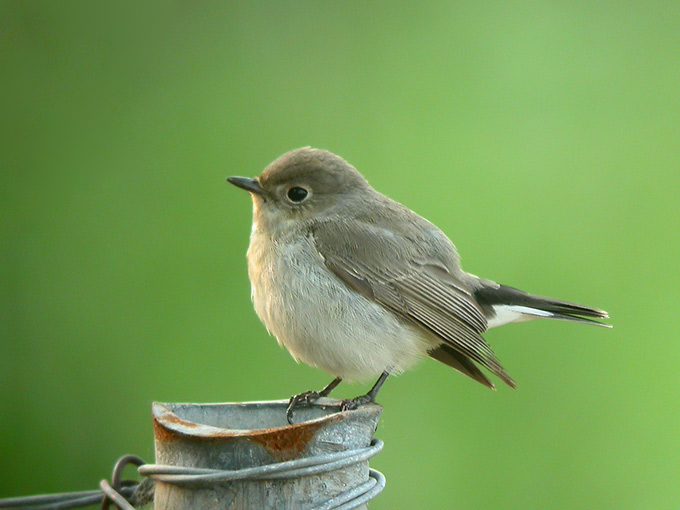
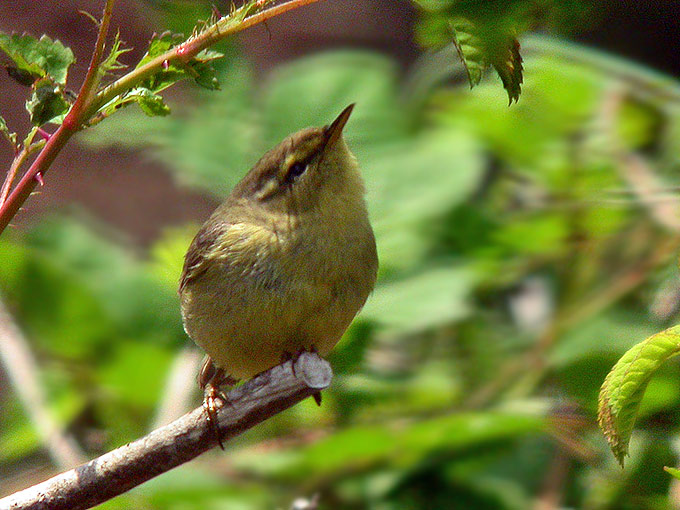
Socheong Island, May 12
With banks of fog and cloud with drizzle until dawn followed by afternoon sunshine, large-scale movement was anticipated, and during the day 103 or more species were logged. Most numerous species were Chestnut Bunting (with 500 around the island, some obviously exhausted, and a further 720 counted moving north in just 30 minutes shortly after dawn), Black-faced Bunting (100, and 50 moving north), Eastern Yellow Wagtail (80, and 25 moving north) and Olive-backed Pipit (with 70 around the island, and 60 counted moving north shortly after dawn). Further highlights included a male Amur Falcon, 10 White-throated Rockthrush, at least 8 Taiga Flycatcher,13 Daurian Starling, and the second record of 2009 (and the fifth national record to date) of Tickell’s Leaf Warbler, this one in the stream in Second Village.
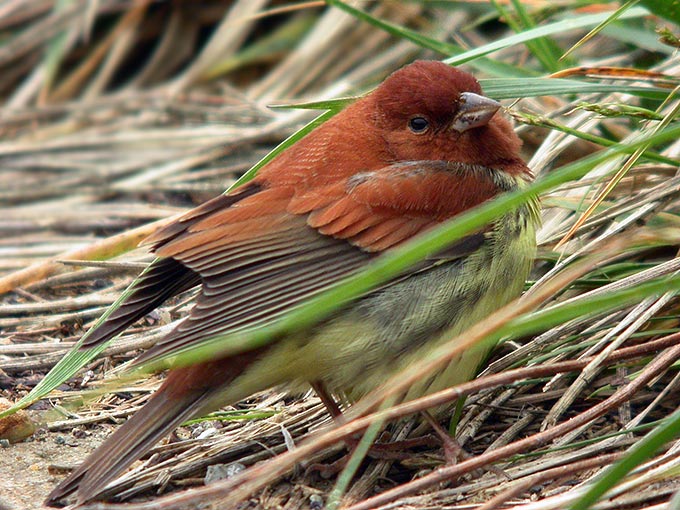
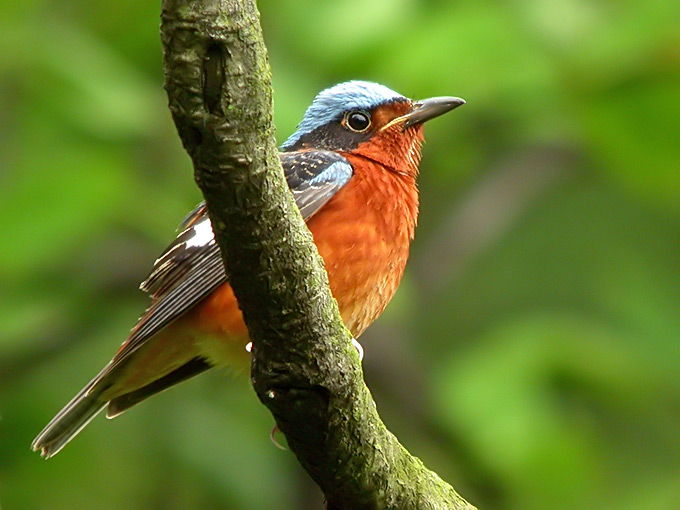
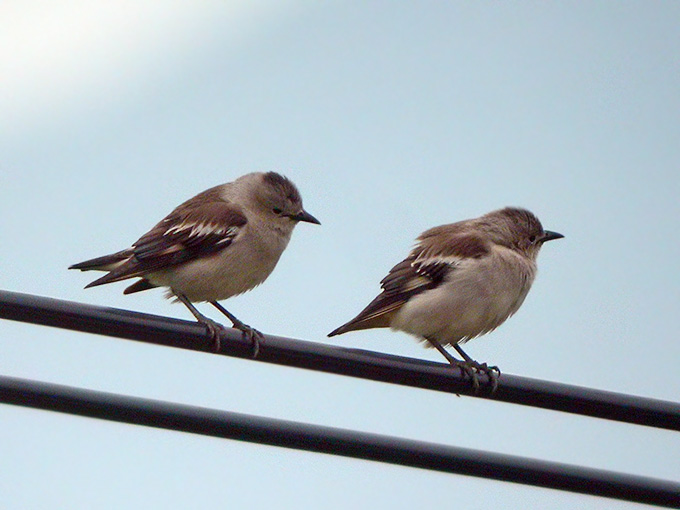
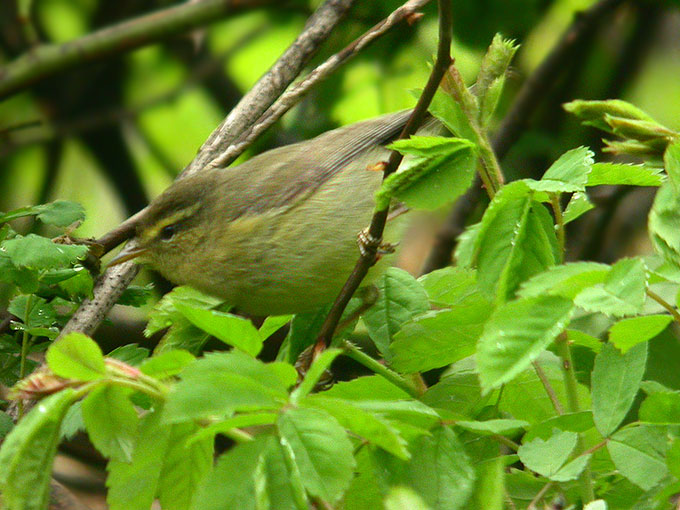
Socheong Island, May 11
With heavy rain for much of the day, followed by heavy overcast and rain showers over night, the beginning of a major arrival of migrants. During the day, highlights included a Chinese Egret, a flock of 110 Wood Sandpiper moving north, which also carried with it at least single Marsh Sandpiper and Spotted Redshank, and c180 Chestnut Bunting. Even more interesting migration seemed to take place at night, when over 30 different species were logged calling/sound recorded in only an hour, including a Broad-billed Sandpiper, what appeared to be some species of tern and a Grey-headed Lapwing!
Shiripdae, May 10
Best in the dappled woods today 4 closely observed Asian Stubtail: 1 appeared to be guarding a nest in the thicket at the base of a larger tree- she would scuttle in, rodent-like, and imperceptibly depart the other side. Also, 5 Mugimaki and 1 Blue-and-White Flycatcher in the topmost pines: Black-naped Oriole are back in residence, with also 2 Yellow-browed and 1 Eastern Crowned Warbler, a Rufous-tailed Robin, Grey-backed Thrush and an Oriental Scops Owl.
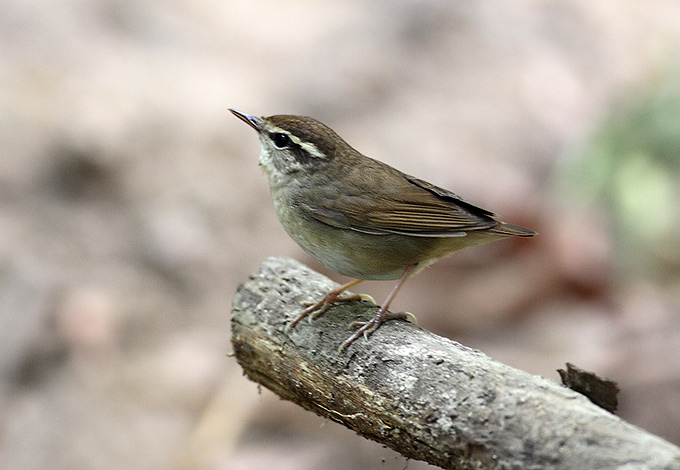
Yanggu, x wetlands, fields and forests, May 10
Spring is always good for birds, with many on migration and breeding.
On May 3, I saw Cattle Egrets for the first time this year in Yanggu. Little Egrets, Great Egrets, Grey Herons and Striated Herons were seen along the river too. In the rice fields I saw Spot-billed Ducks and Mandarin Ducks.
Then on May 4, a walk upstream along the river in the evening produced a Chinese Pond Heron and Great Egrets.
On May10, there were Great Egrets, Little Ergets, Grey Herons and Striated Herons along the river. I also saw numerous Little Ringed Plovers, including a fledgling.
In the forest in the last week or so I have heard, a Northern Hawk Cukoo, Grey Nightjar, Eurasian Scops Owl, Northern Boobook, Eurasian Eagle Owl, Asian Stubtails and Eastern Crowned Warblers.
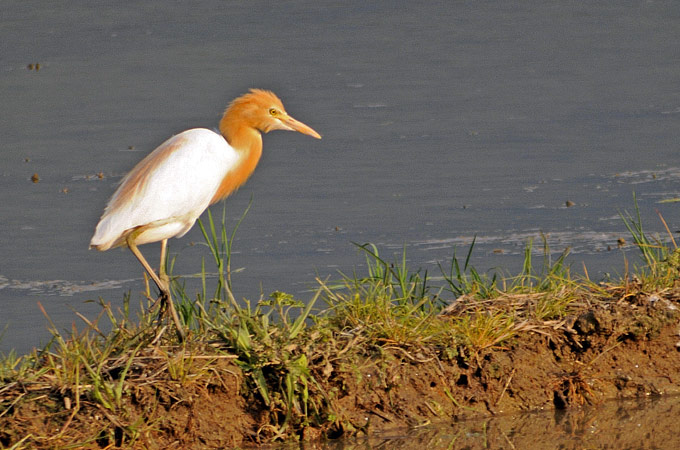
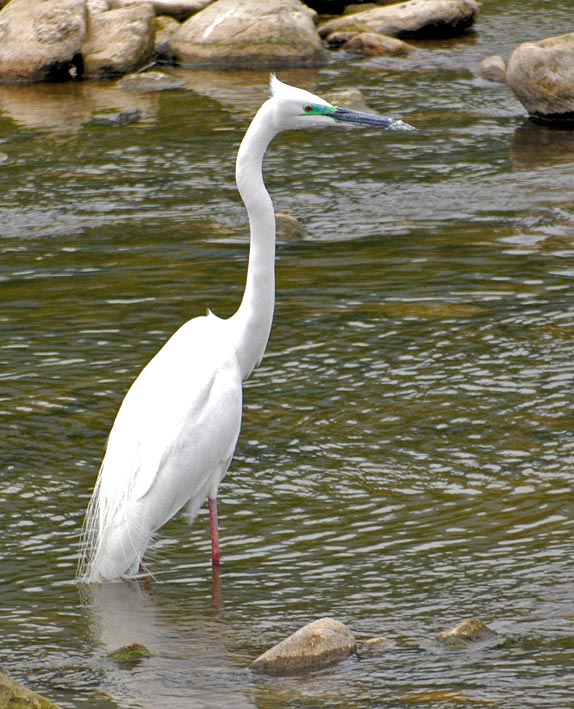
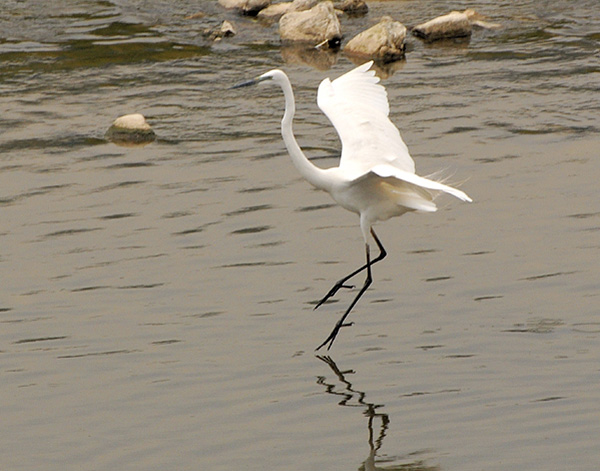
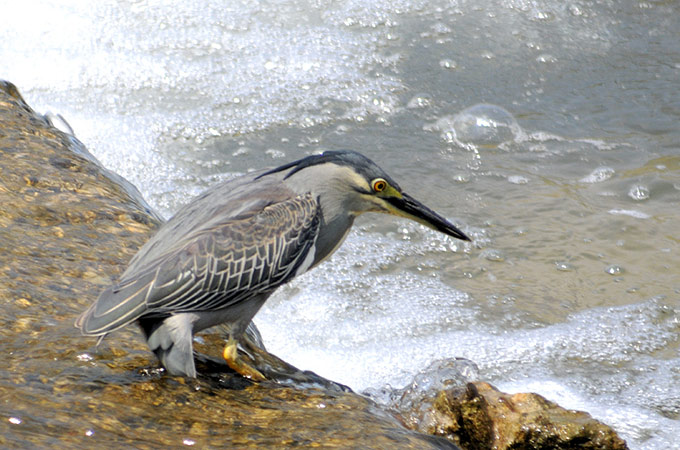
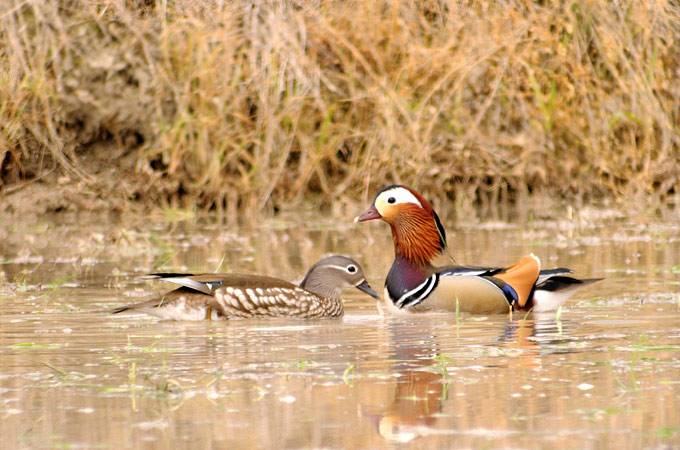
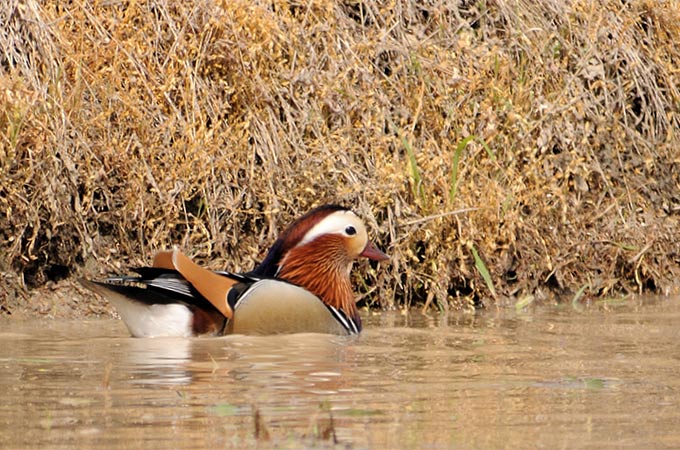
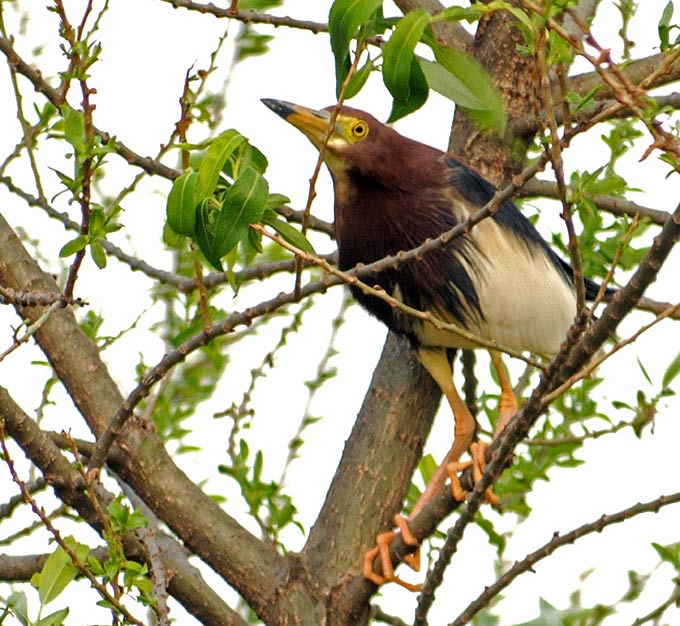
Socheong Island, May 10
With a (near-?) full moon increasingly covered by cloud during the night, followed by dense fog and Force 3-4 south-easterlies and then a spell of heavy rain at midday, in turn followed by southerlies, this was a day of two halves, with limited movement in the morning, apparently increasing as visibility rose from 200 m to 5 km+ by late-afternoon/evening. In the morning, highlights included a Yellow Bunting and a Narcissus Flycatcher in the east of the island, another Hume’s Leaf and the personal first Arctic Warbler of the spring, and a breeding-plumaged male Ochre-rumped Bunting on North Point. In the afternoon, there were at least 44 Chinese Grosbeak in the west of the island, and what appeared to be a strong movement of Streaked Shearwater north past the lighthouse (a 10 minute sample count of the steady stream reached 138), where there were also 5 Finless Porpoise and at least one Spotted Seal. Other species of note included the personal first White-throated Needletail (very scarce this spring?) and White-throated Rockthrush. Outstanding highlight came just before dark, when an unusual call (rather Lanceolated Warbler like, with lots of tiks and tit-tit-tup) was heard coming from a small, plain brown-backed warbler flitting anxiously on the ground, presumably as it readied to roost. Good views at close range over 3 minutes or so were had of the bird, which appeared similar to a slightly-built Radde’s Warbler, but with a uniformly toned supercilium, a strong yellowish-buff wash on the underparts, richest on the vent, and pinkish-brown legs (lacking the “big orange feet” of most Raddes’): based on the call (atypical as it might be?), identified as Korea’s second Yellow-streaked Warbler. Unfortunately, no images or sound recordings were managed.
Socheong Island, May 9
A fairly quiet journey back to Socheong on the Marine Bridge ferry, with obvious highlight/disappointment being a breeding-plumaged presumably Yellow-billed Loon. Seen at 200 m range in fair light, the bird’s plumage was well seen as the bird took off and flew heavily way, but the bill when seen appeared surprisingly dark ... On the island itself, in weak sunshine and then overcast conditions, good numbers of Yellow-browed Warbler (180), with the “phyllosc flocks” including at least one Hume’s Leaf and the personal first Two-barred Greenish Warbler of the spring, and lesser numbers of Raddes’ (14) and Dusky Warblers (12).
Eocheong Island, May 5 & 6
The clear-out of the 4th continued. Fog in the morning gave way to warm sunshine. The Wheatear seemed to have moved on, as had the Common Rosefinches and many of the buntings. New birds noted were a Sharp-tailed Sandpiper, Common Sandpiper and a Broad-billed Sandpiper along with the Greenshank and Terek Sandpipers seen the day before. A Little Egret added to the egret mix.
A few more wagtails showed; most notably, two taivana Yellow Wagtails near the shorebirds. In the vegetable gardens, a Blyth’s Pipit joined several Richard’s Pipits. These we joined briefly by several Dusky Warblers, the Rubythroat, a Radde’s Warbler and a female Eyebrowed Thrush.
The 6th was quieter still, with limited time spent in the field before the boat. Surprisingly, the return trip over calm waters proved quite interesting, with a Black-naped Oriole flying toward Eocheong and a Purple Heron flying purposefully north. Best of all was at Yundo, with a reasonably good (if brief) look at an apparent Saker Falcon flying low over the sea onto the island: an obviously large, broad-winged and bulky falcon showing the powerful flight and “springy wingtips” characteristic of large falcons, a good deal of white on the head, and brown upperparts. This follows a Saker seen a year ago (April 21) on Eocheong by Nial Moores and me; perhaps the bird is a more regular migrant through the western islands than suspected? Also from the boat: two separate flocks totaling 13 Ancient Murrelets.
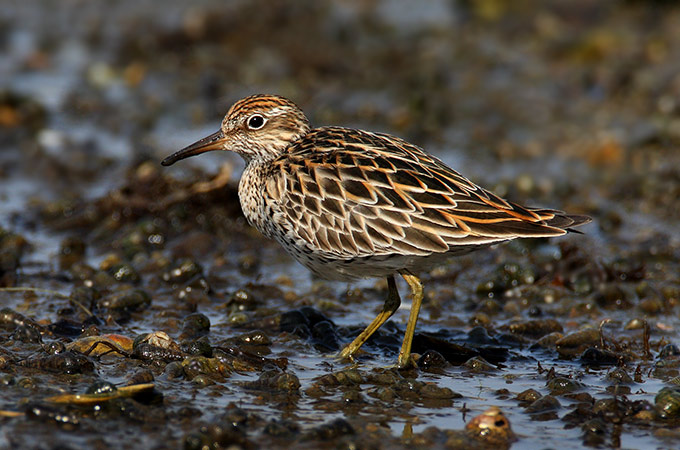
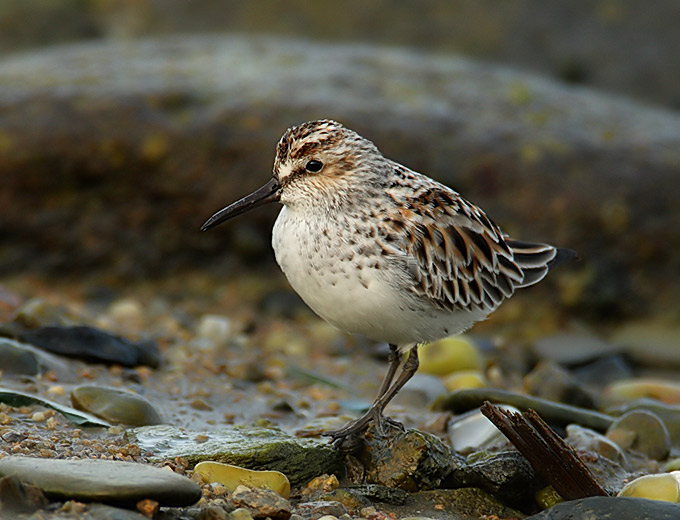
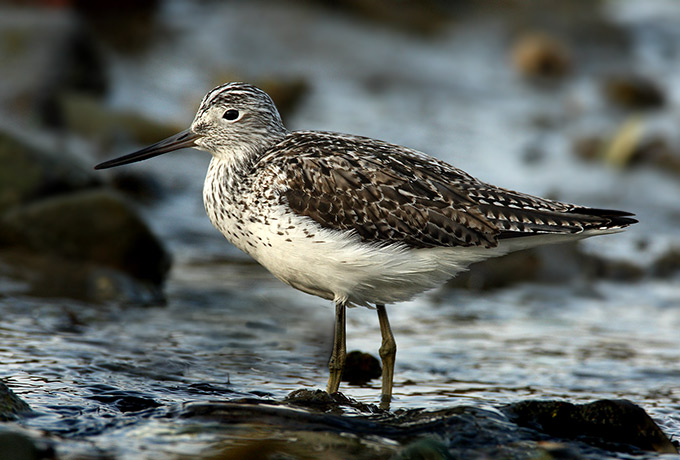
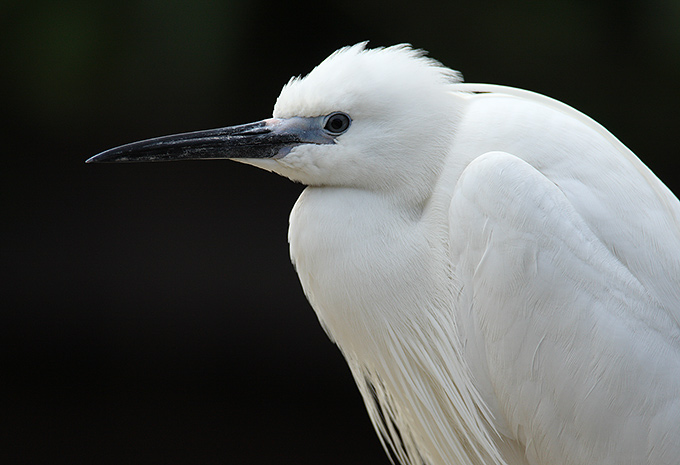
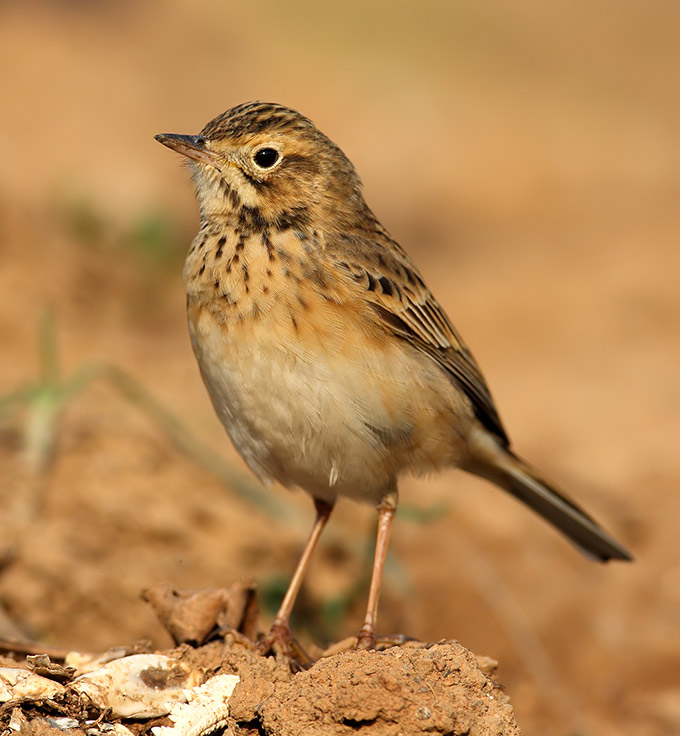
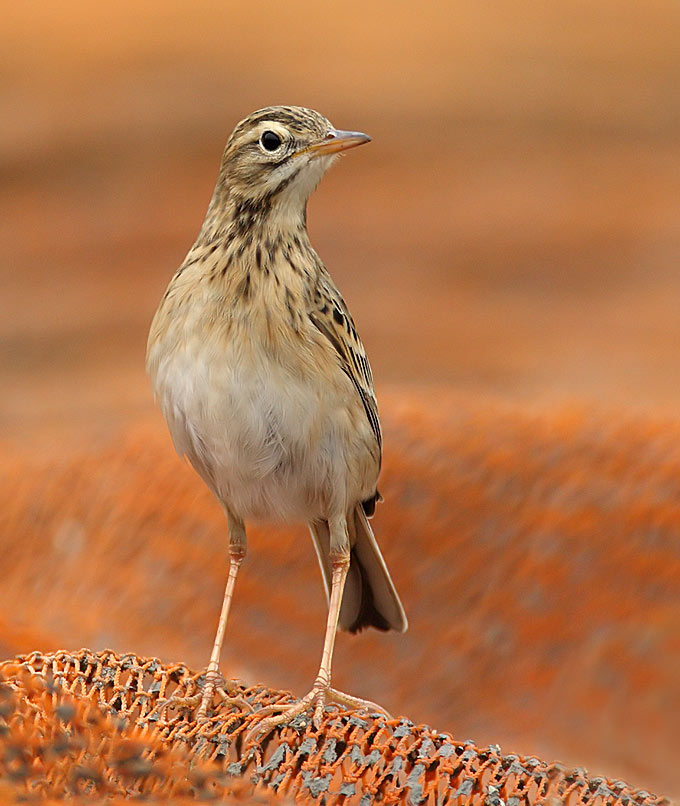

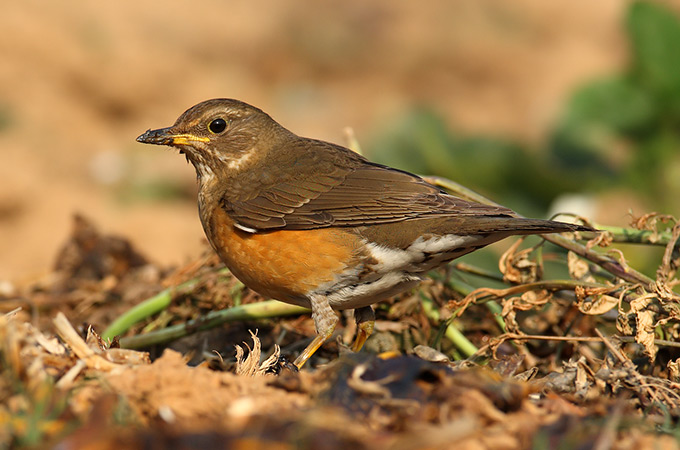
Seogwipo, Jeju island, May 6
The sunny and hot south side of Jeju has been a bit quiet as far as migrants go during the past week. In the farm field where the White-shouldered Starling was spotted, 2 female Chestnut-cheeked Starlings have been seen regularly for about a week. A dozen Cattle Egret and about 6 Intermediate Egret regularly patrol this field. A female Bull-headed Shrike was seen feeding her 3 gape-mouthed and shrieking young, who were also clumsily testing out their wings. Red-rumped Swallows temporarily outnumbered Barn Swallow (25:15) over this field a few days ago, but during the past few days, only 3 have been seen here.
In a nearby park, a Japanese White-eye collected spider webs for a nest, while an immature male Narcissus Flycatcher perched in a riverside tree. No sign of the Grey Buting that was seen here 2 weeks ago.
On the coast, Blue Rock Thrush entertained with both their boldness, and their aerobatic swooping and dive-bombing courtship displays. A disheveled and lethargic fledgeling was an interesting counterpoint to the energetic displays.
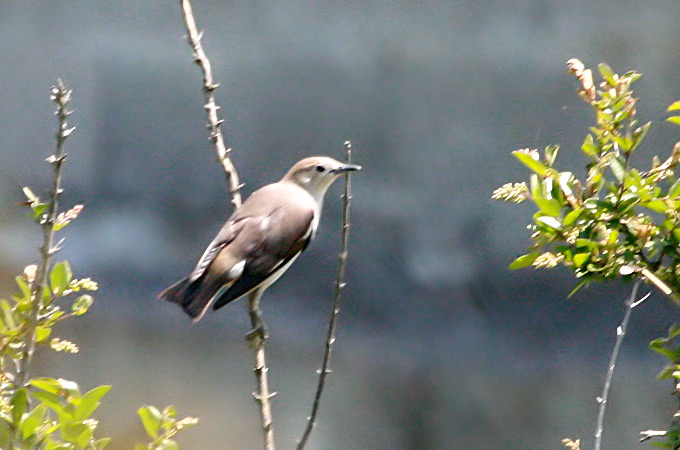
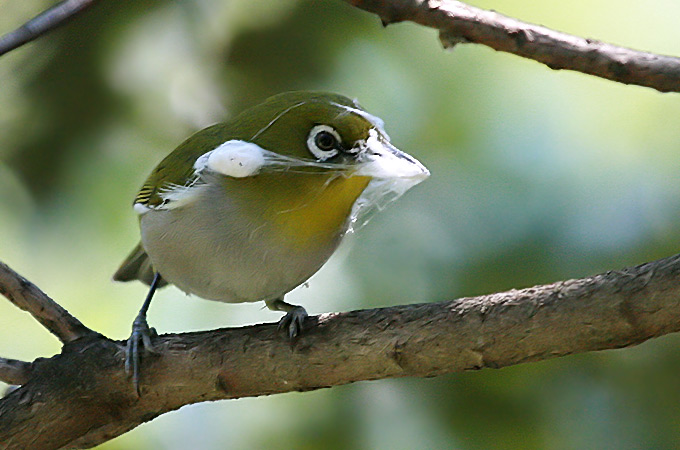
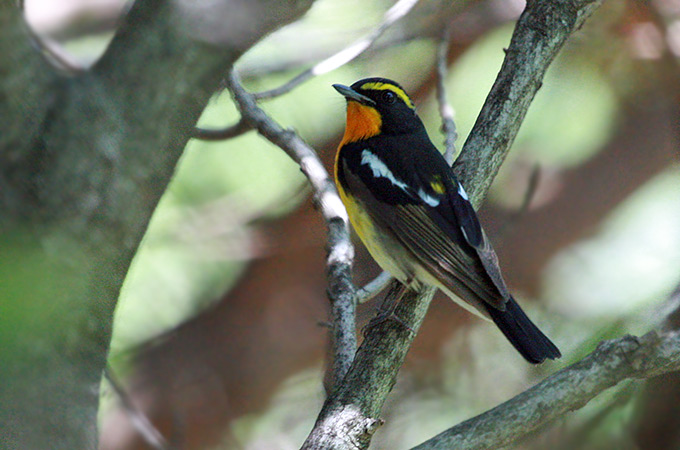
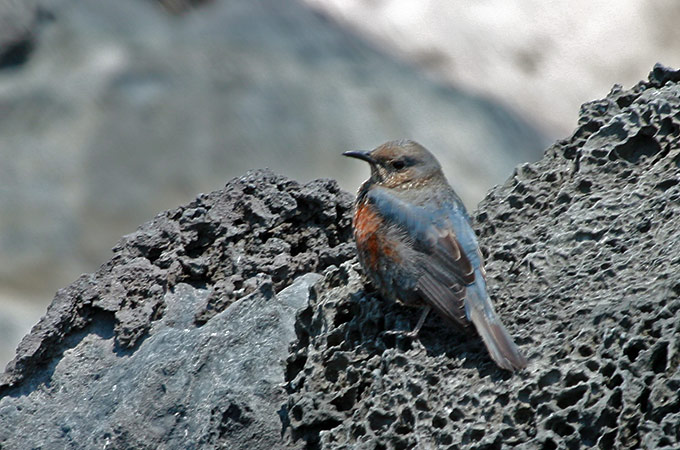
Eocheong Island, May 3 & 4
The hoped-for fall of migrants after the 2nd’s rain failed to materialize. Fewer birds in evidence overall: a few Yellow-breasted Buntings, a Black-capped Kingfisher and several Yellow Wagtails (including a taivana) seemed new in. A walk to the lighthouse gleaned a (heard only) group of Japanese Whiteyes, a Black-naped Oriole a calling Oriental Scops Owl and, at the pagoda, 2 Pacific Swifts, a White-throated Needletail and an Asian House Martin along with the Barn Swallows. The Siberian Rubythroat (and another heard calling toward the lighthouse), Scaly, Brown-headed and Eye-browed Thrushes still showed.
Near the quarry, a couple more Richard’s Pipits and a Pallas’ Reed Bunting and, on the shore rocks, the Desert Wheatear still, looking plumper and fluffier than previous days.
The 4th was quieter still: new birds were a pair of Taiga Flycatchers associating with a Brown Flycatcher, 5 Chinese Grosbeaks, a Hoopoe, several Japanese Whiteyes near the school, somewhat more numbers of Dusky Warblers, an Intermediate Egret, 2 Grey Tattlers, a Terek Sandpiper and a Common Greenshank. I watched the Whiteyes and the Common Rosefinches feeding on flowers; the former probed, often disappearing halfway into the blossom; the Rosefinches would tear off a flower, suck nectar, then neatly spit the flower out.
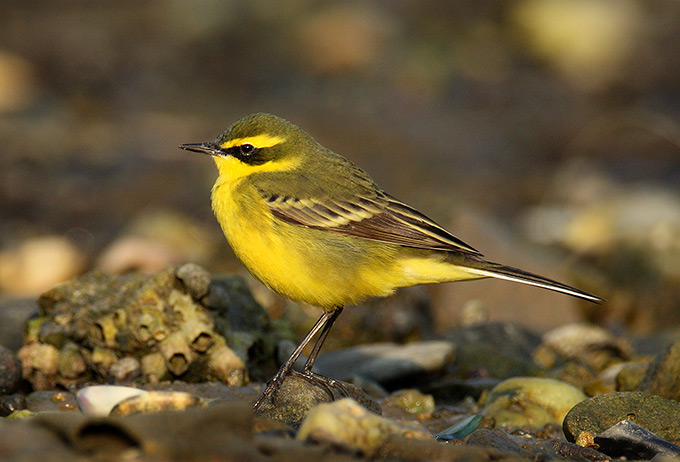
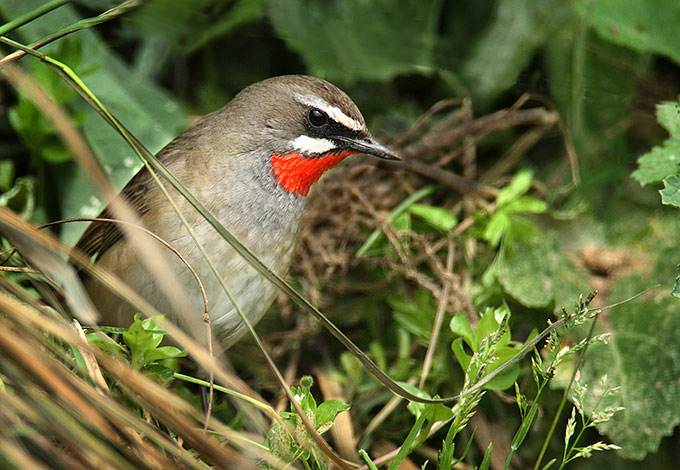
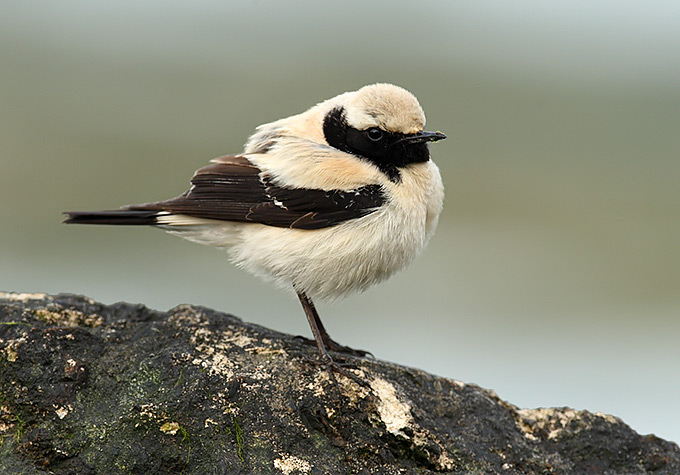
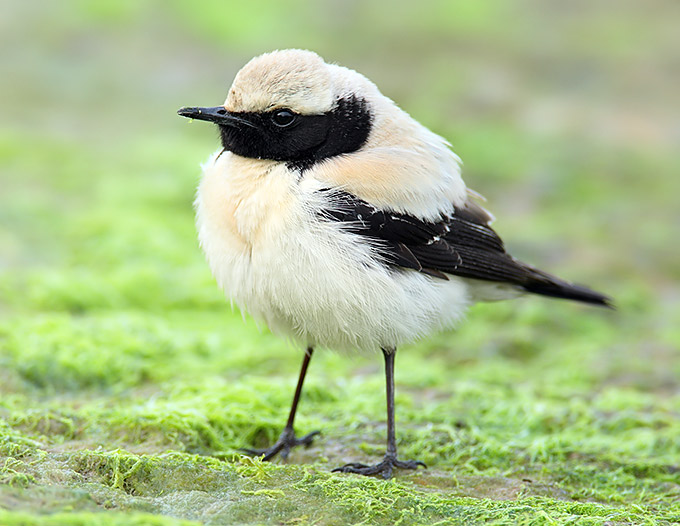
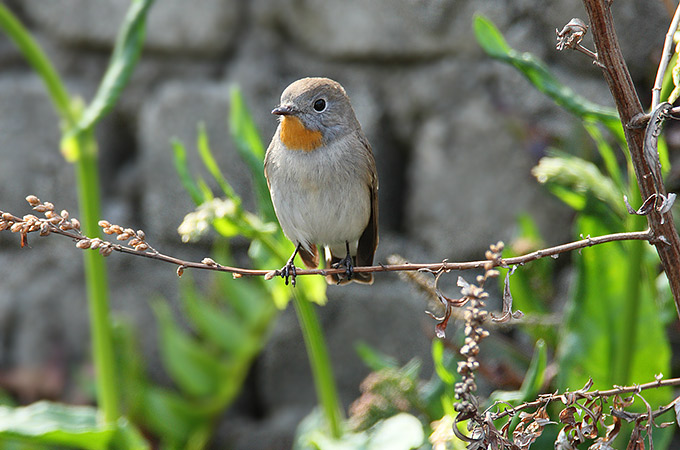
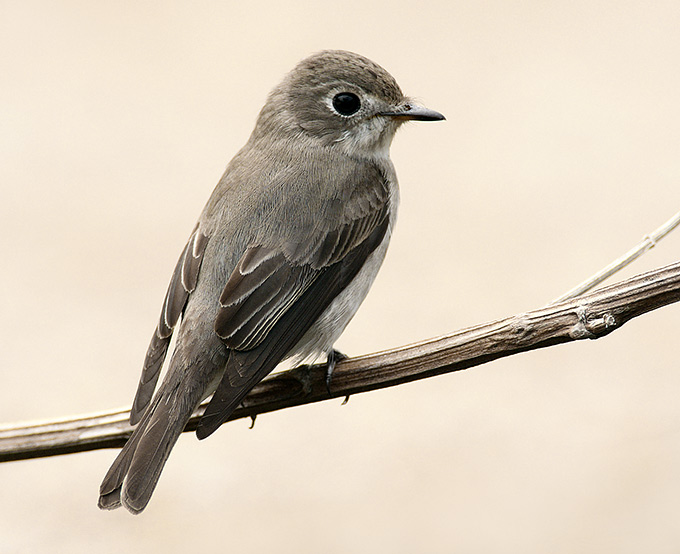
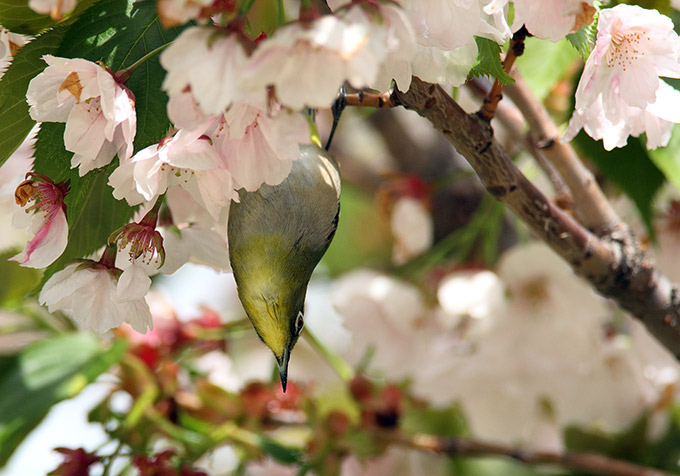
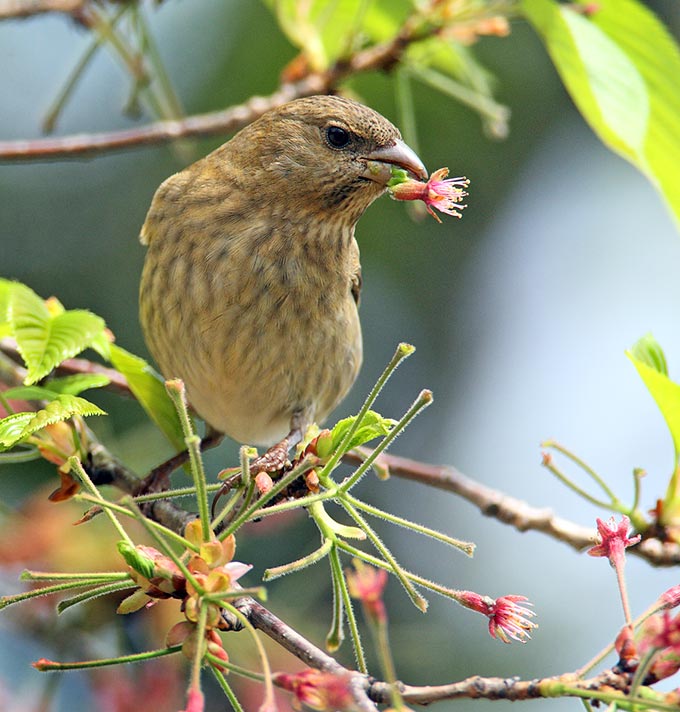
Uiwang, May 4
On this usually peaceful reservoir today,& 3 motor-boats, 4 fishing dinghies, music booming out of giant loudspeakers, huge kites, a helicopter, paraglider, and& fishermen& standing in rows& along the bank. Most birds had fled the scene,& but left to guard their nests were 21 Great Crested Grebes (which took shelter in the reeds), and an outraged& Common Kingfisher.
In nearby flooded ricefields however,& 26 Common Snipe, at least 70 Wood Sandpiper, 3 Common Sandpiper& and& 7 Long-toed Stint.

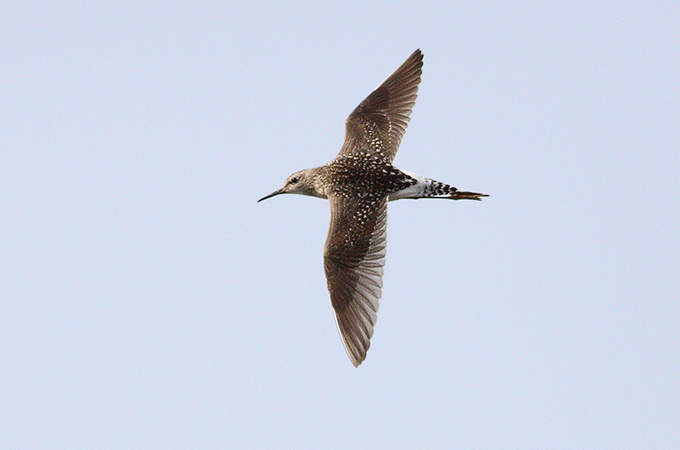
Dokjeok Island, May 3
A thick mist enshrouded the island in the morning, after a crossing enlivened by 6 Common Tern and several Finless Porpoise: 3 Mongolian Gull adults were in the harbour (perhaps breeding nearby?), a Common Kingfisher on the beach, and further offshore, a decidedly late Red-breasted Merganser liesurely rolling over and preening in the waves.
The first hour revealed generally low numbers of migrants, with 40+ Black-faced Bunting,30 Olive-backed Pipit and c.20 Yellow-browed Warbler the dominant species.
The rice paddies were unusually deserted, save for 1 ocularis White Wagtail and 4 Richard's Pipit: in the largely destroyed former scrub area, 2 Chestnut-eared Bunting & 2 Little Bunting.
A stroll through the woodland clearings of the southwest corner yielded 8 Yellow-browed Bunting,a late Dusky Thrush,7 Tristram's Bunting, 1 Narcissus Flycatcher, the spring's first Dollarbird, 3 Blue-and-white Flycatcher, a White's Thrush, 6 Mugimaki, 3 Grey-streaked Flycatcher, and 2 Pale-legged Leaf Warbler, making a quick 40 species, before i relinquished the island to the hordes of holidaymakers.
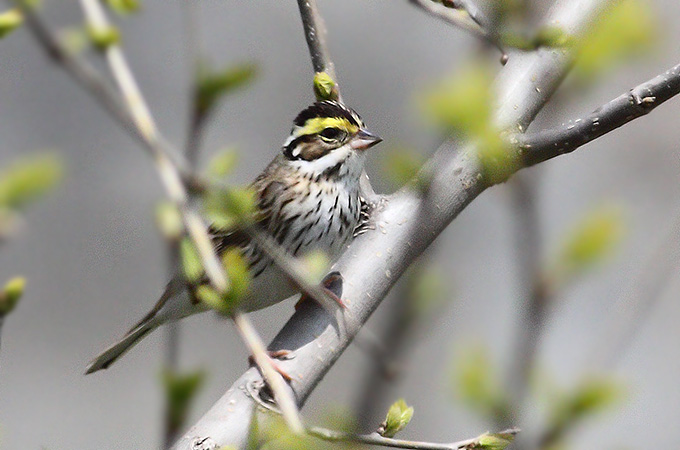
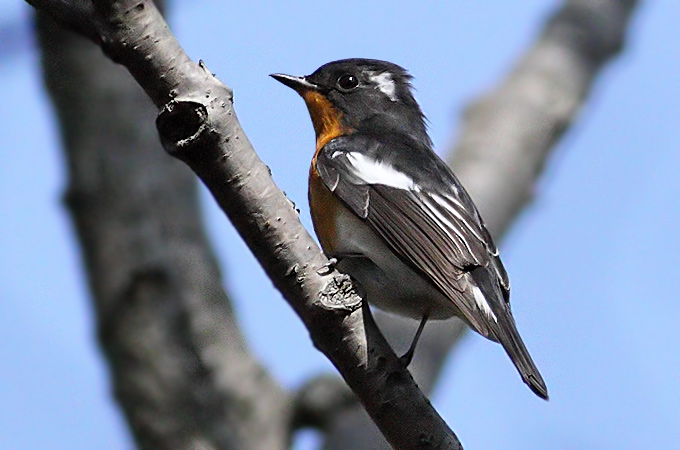
Gageo Island, May 3
With rain until 5 AM and only light south-westerlies, good coverage of 1-Gu and 2-Gu and 96 species logged. Numbers of “grounded migrants” remained small, with most numerous species counted being Barn Swallow (170), Red-rumped Swallow (50), Brambling (60) and Eastern Yellow Wagtail (57). Almost all of the day’s highlights were concentrated in the Hangri top fields, with one bush alone there in one hour holding two Light-vented Bulbul, a single Daurian and four White-shouldered Starlings (3 males and one female), and best of all a single Tickell’s Leaf Warbler, extremely poorly photographed, but highly vocal and sound-recorded. This is only the fourth record of the species in Korea, with all three (or four) previous individuals seen on Socheong Island between May 19th and 24th, 2005.
By the same bush there were also 15 Chinese Grosbeak and an extremely dark male Daurian Redstart - black upperparts, dark grey crown, and deep reddish underparts lacking orange tones - a worn auroreus or an extralimital leucopterus?
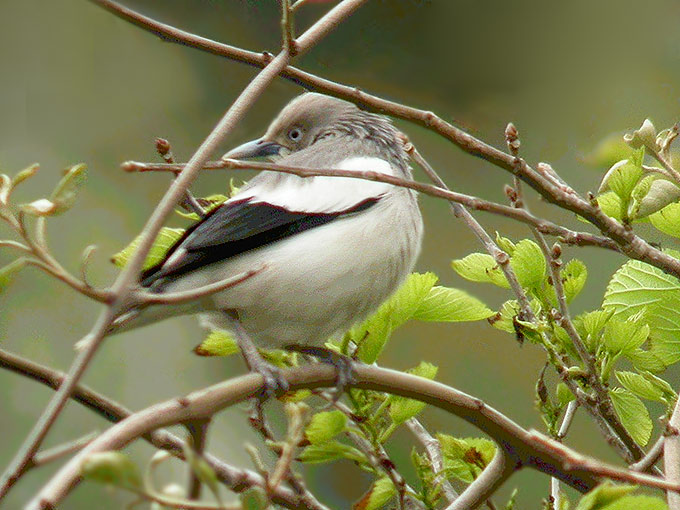
Gageo Island, May 2
With rain moving in during the afternoon, highlights included the personal largest hirundine flock of the spring so far (though still including only 250 Red-rumped and 120 Barn Swallows: where are the flocks of 1000 or more swallows that were recorded several times in spring here and e.g. on Eocheong earlier this decade?), and the personal first Taiga Flycatcher of the spring.
Eocheong Island, May 1 & 2
From the ferry: a Whimbrel, 30+ Bar-tailed Godwits, 12 Far Eastern Oystercatchers, 2 Common Terns, 5 Ancient Murrelets. A large team of Japanese and Korean birders were headed for Eocheong as well.
On the island, single digits of Brown, Dusky, Naumann’s, Eyebrowed, Grey-backed, Grey and Scaly Thrush. Also single digits of Dusky, Eastern Crowned, Pale-legged Leaf, Korean Bush and Oriental Reed Warblers; 1 Black-browed Reed and 10 Yellow-browed Warblers.
Buntings also in small numbers: Tristram’s, Yellow-browed, Yellow-throated, Little, Yellow (1) and Black-faced Buntings.
Shorebirds were represented by Green and Wood Sandpipers and, in the evening, a single Little Whimbrel. Also: 2 Chinese Pond Herons, 1 Night Heron, 1 Grey Heron and 3 Cattle Egrets.
Other birds included 1 Kingfisher, 7 Siberian Blue Robin, 2 Siberian Rubythroat , 1 Hawfinch, 20+ Brambling and 2 each of Blue and White and Brown Flycatchers. Raptors were represented by a Scops Owl, 2 Chinese Sparrowhawk and a Peregrine Falcon.
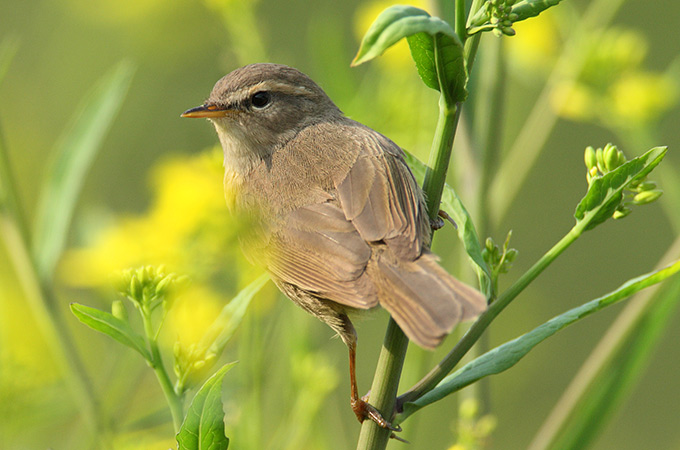
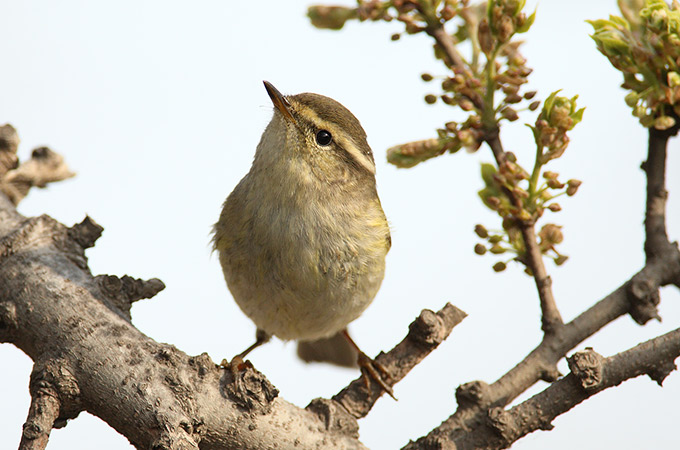
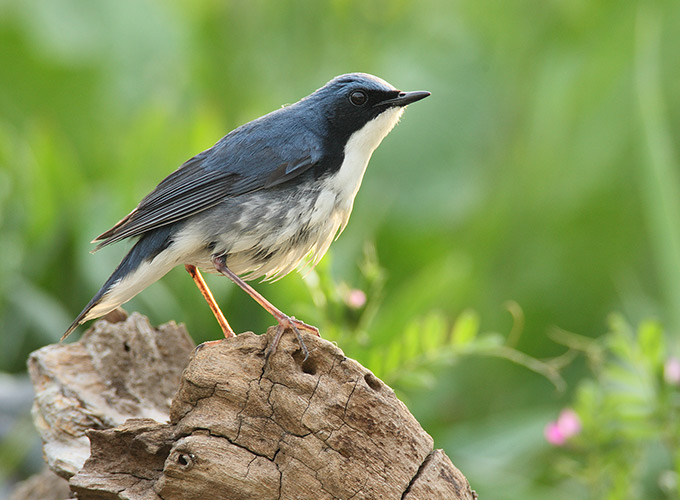
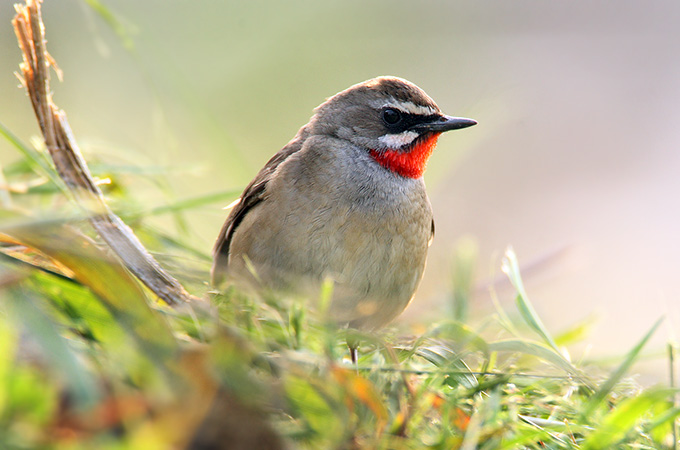
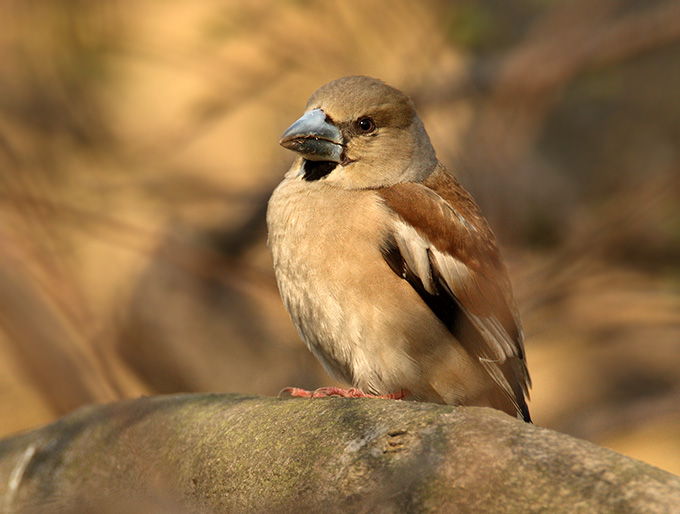
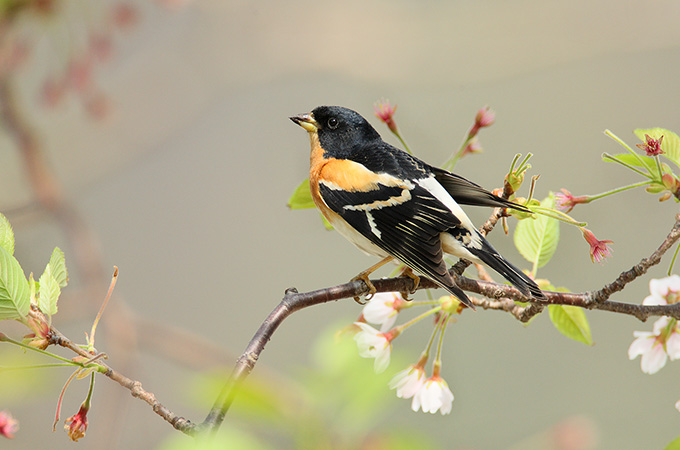
May 2 began with heavy overcast and relatively little movement; new birds included Richard’s and Blyth’s Pipits, about 9 Ashy Minivets, 2 Asian Stubtail, 3 Chinese Grosbeak, 4 Common Rosefinch, 1 Brown Shrike, Chestnut Bunting and Yellow-breasted Bunting.
Highlight of the day was first spotted by Choi Seung Hoon: a Desert Wheatear Oenanthe deserti, Korea’s second record. The first record was January 26th 2008 at Pohang.

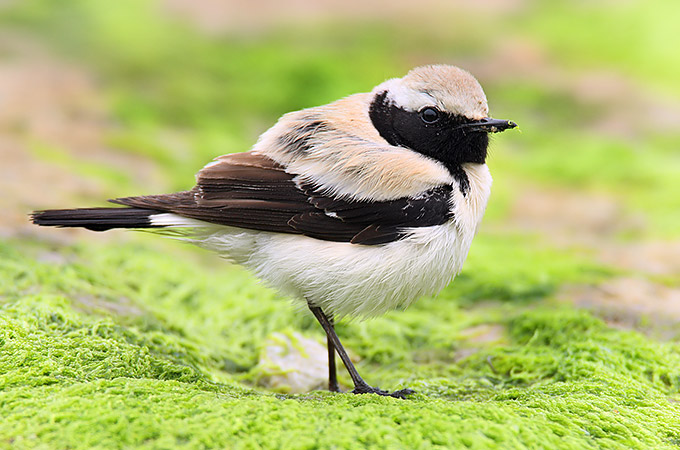
Gageo Island, May 1
In light south-westerlies, highlights during the 1-Gu circuit included 2 Chestnut-cheeked Starling, one or two Greater Short-toed Lark, a Blyth’s Pipit and the personal first Forest Wagtail of the spring.
Birds Korea 1108 Ho, 3 Dong, Samick Tower Apt., 148-22, Namcheon-Dong, Su-Young-Gu
Busan, 618-762 Republic of Korea





